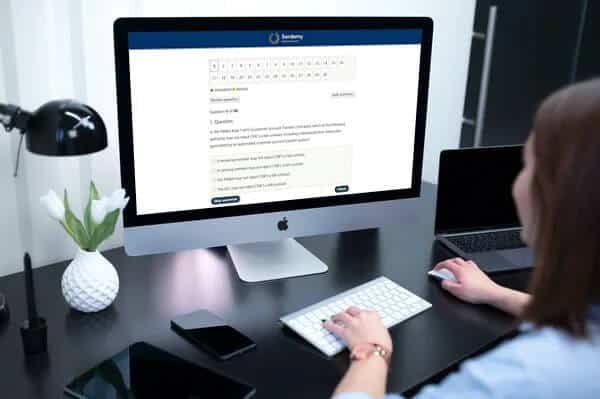Quiz-summary
0 of 30 questions completed
Questions:
- 1
- 2
- 3
- 4
- 5
- 6
- 7
- 8
- 9
- 10
- 11
- 12
- 13
- 14
- 15
- 16
- 17
- 18
- 19
- 20
- 21
- 22
- 23
- 24
- 25
- 26
- 27
- 28
- 29
- 30
Information
Premium Practice Questions
You have already completed the quiz before. Hence you can not start it again.
Quiz is loading...
You must sign in or sign up to start the quiz.
You have to finish following quiz, to start this quiz:
Results
0 of 30 questions answered correctly
Your time:
Time has elapsed
Categories
- Not categorized 0%
- 1
- 2
- 3
- 4
- 5
- 6
- 7
- 8
- 9
- 10
- 11
- 12
- 13
- 14
- 15
- 16
- 17
- 18
- 19
- 20
- 21
- 22
- 23
- 24
- 25
- 26
- 27
- 28
- 29
- 30
- Answered
- Review
-
Question 1 of 30
1. Question
As the Financial and Operations Principal for Apex Securities, an introducing broker-dealer, you are finalizing the firm’s month-end net capital computation. A review of the firm’s proprietary trading account and trial balance reveals the following information: – Net Worth: $2,000,000 – Non-Allowable Assets: $300,000 – Other Charges (including fidelity bond deductible): $50,000 – A long position in a single non-exempt common stock, “Stellar Dynamics Corp.”, with a market value of $250,000. Based on SEA Rule 15c3-1, what is the total haircut that must be applied to the Stellar Dynamics Corp. position for the net capital computation?
Correct
First, calculate the firm’s Tentative Net Capital (TNC). TNC is determined by taking Net Worth and subtracting non-allowable assets and other charges. \[ \text{TNC} = \text{Net Worth} – \text{Non-Allowable Assets} – \text{Other Charges} \] \[ \text{TNC} = \$2,000,000 – \$300,000 – \$50,000 = \$1,650,000 \] Next, determine the standard haircut for the common stock position. Under SEA Rule 15c3-1, the standard haircut for common stock is 15%. \[ \text{Standard Haircut} = 0.15 \times \$250,000 = \$37,500 \] Then, assess if an undue concentration charge applies. An undue concentration exists if the market value of a single non-exempt security exceeds 10% of the firm’s TNC. \[ \text{Concentration Threshold} = 0.10 \times \text{TNC} = 0.10 \times \$1,650,000 = \$165,000 \] Since the position’s market value of $250,000 is greater than the $165,000 threshold, an undue concentration exists. The additional haircut is calculated on the market value in excess of this threshold. \[ \text{Excess Market Value} = \$250,000 – \$165,000 = \$85,000 \] The undue concentration haircut is 15% of this excess amount. \[ \text{Undue Concentration Haircut} = 0.15 \times \$85,000 = \$12,750 \] Finally, the total haircut for the position is the sum of the standard haircut and the undue concentration haircut. \[ \text{Total Haircut} = \text{Standard Haircut} + \text{Undue Concentration Haircut} \] \[ \text{Total Haircut} = \$37,500 + \$12,750 = \$50,250 \] The net capital rule, SEA Rule 15c3-1, is a cornerstone of broker-dealer financial responsibility. A key component of the net capital computation is the application of haircuts to proprietary securities positions to account for market risk. For a position in a single class of non-exempt equity securities, a standard haircut is applied. However, to mitigate the risk of a firm holding an overly large position in a single security, the rule requires an additional undue concentration haircut. This is mandated by Rule 15c3-1(c)(2)(vi)(M). The process begins with calculating Tentative Net Capital, which is the firm’s net worth less any assets not readily convertible to cash and other specified deductions. The undue concentration threshold is set at 10 percent of this Tentative Net Capital. If a single security position’s market value exceeds this threshold, the firm must take an additional 15 percent haircut on the value of the position that is in excess of the threshold. It is critical to understand that this concentration haircut is applied in addition to the standard 15 percent haircut that is taken on the entire market value of the position. This cumulative effect significantly increases the capital charge for concentrated positions, incentivizing firms to maintain diversified proprietary accounts.
Incorrect
First, calculate the firm’s Tentative Net Capital (TNC). TNC is determined by taking Net Worth and subtracting non-allowable assets and other charges. \[ \text{TNC} = \text{Net Worth} – \text{Non-Allowable Assets} – \text{Other Charges} \] \[ \text{TNC} = \$2,000,000 – \$300,000 – \$50,000 = \$1,650,000 \] Next, determine the standard haircut for the common stock position. Under SEA Rule 15c3-1, the standard haircut for common stock is 15%. \[ \text{Standard Haircut} = 0.15 \times \$250,000 = \$37,500 \] Then, assess if an undue concentration charge applies. An undue concentration exists if the market value of a single non-exempt security exceeds 10% of the firm’s TNC. \[ \text{Concentration Threshold} = 0.10 \times \text{TNC} = 0.10 \times \$1,650,000 = \$165,000 \] Since the position’s market value of $250,000 is greater than the $165,000 threshold, an undue concentration exists. The additional haircut is calculated on the market value in excess of this threshold. \[ \text{Excess Market Value} = \$250,000 – \$165,000 = \$85,000 \] The undue concentration haircut is 15% of this excess amount. \[ \text{Undue Concentration Haircut} = 0.15 \times \$85,000 = \$12,750 \] Finally, the total haircut for the position is the sum of the standard haircut and the undue concentration haircut. \[ \text{Total Haircut} = \text{Standard Haircut} + \text{Undue Concentration Haircut} \] \[ \text{Total Haircut} = \$37,500 + \$12,750 = \$50,250 \] The net capital rule, SEA Rule 15c3-1, is a cornerstone of broker-dealer financial responsibility. A key component of the net capital computation is the application of haircuts to proprietary securities positions to account for market risk. For a position in a single class of non-exempt equity securities, a standard haircut is applied. However, to mitigate the risk of a firm holding an overly large position in a single security, the rule requires an additional undue concentration haircut. This is mandated by Rule 15c3-1(c)(2)(vi)(M). The process begins with calculating Tentative Net Capital, which is the firm’s net worth less any assets not readily convertible to cash and other specified deductions. The undue concentration threshold is set at 10 percent of this Tentative Net Capital. If a single security position’s market value exceeds this threshold, the firm must take an additional 15 percent haircut on the value of the position that is in excess of the threshold. It is critical to understand that this concentration haircut is applied in addition to the standard 15 percent haircut that is taken on the entire market value of the position. This cumulative effect significantly increases the capital charge for concentrated positions, incentivizing firms to maintain diversified proprietary accounts.
-
Question 2 of 30
2. Question
Vanguard Introducing Services, an introducing broker-dealer, operates under a formal, written expense-sharing agreement with its parent company, Apex Financial Holdings. The agreement, which has been filed with FINRA, explicitly states that Apex will pay the monthly office lease of $25,000 on behalf of Vanguard and that Vanguard has no obligation, either direct or indirect, to reimburse Apex for this cost. For the month of May, Apex pays the $25,000 lease payment as stipulated. How must Vanguard’s Financial and Operations Principal direct this transaction to be recorded for the purposes of its month-end FOCUS report and net capital computation?
Correct
The correct accounting and regulatory treatment for an expense paid by a parent company on behalf of its broker-dealer subsidiary, under a properly structured expense-sharing agreement, requires the broker-dealer to recognize the expense on its own books. The corresponding entry is a credit to additional paid-in capital (APIC), not a liability. The journal entry would be: Debit: Rent Expense for the value of the rent paid. Credit: Additional Paid-in Capital (APIC) for the same amount. This treatment is based on guidance from FINRA and the SEC regarding affiliate transactions and expense-sharing agreements. For this treatment to be valid, the agreement must be formal, in writing, and explicitly state that the broker-dealer has no direct or indirect obligation to repay the parent for the specified expenses. By recording the expense, the firm’s net income is reduced, which decreases retained earnings and thus net worth. However, the simultaneous credit to APIC increases net worth by the exact same amount. Therefore, the net effect on the firm’s total net worth is zero. Crucially, because no liability is created, there is no increase in the firm’s aggregate indebtedness. This prevents the firm’s net capital from being negatively impacted by the transaction, as would happen if a liability were recorded. This approach ensures that the broker-dealer’s financial statements accurately reflect the economic substance of its operations, including all costs of doing business, while also correctly treating the parent’s payment as a capital contribution in the absence of a repayment obligation.
Incorrect
The correct accounting and regulatory treatment for an expense paid by a parent company on behalf of its broker-dealer subsidiary, under a properly structured expense-sharing agreement, requires the broker-dealer to recognize the expense on its own books. The corresponding entry is a credit to additional paid-in capital (APIC), not a liability. The journal entry would be: Debit: Rent Expense for the value of the rent paid. Credit: Additional Paid-in Capital (APIC) for the same amount. This treatment is based on guidance from FINRA and the SEC regarding affiliate transactions and expense-sharing agreements. For this treatment to be valid, the agreement must be formal, in writing, and explicitly state that the broker-dealer has no direct or indirect obligation to repay the parent for the specified expenses. By recording the expense, the firm’s net income is reduced, which decreases retained earnings and thus net worth. However, the simultaneous credit to APIC increases net worth by the exact same amount. Therefore, the net effect on the firm’s total net worth is zero. Crucially, because no liability is created, there is no increase in the firm’s aggregate indebtedness. This prevents the firm’s net capital from being negatively impacted by the transaction, as would happen if a liability were recorded. This approach ensures that the broker-dealer’s financial statements accurately reflect the economic substance of its operations, including all costs of doing business, while also correctly treating the parent’s payment as a capital contribution in the absence of a repayment obligation.
-
Question 3 of 30
3. Question
Momentum Introducing Brokers, an introducing firm that does not carry customer accounts or hold customer funds or securities, is subject to a minimum net capital requirement of $50,000. Alistair, the firm’s Financial and Operations Principal, is reviewing the firm’s financial position at the close of business. He determines that the firm’s current net capital is $72,000 and its aggregate indebtedness stands at $960,000. Based on these figures, what is Alistair’s most immediate regulatory obligation?
Correct
The firm’s minimum net capital requirement is $50,000. The firm’s current net capital is $72,000. The firm’s aggregate indebtedness (AI) is $960,000. First, calculate the ratio of aggregate indebtedness to net capital: \[ \frac{\text{Aggregate Indebtedness}}{\text{Net Capital}} = \frac{\$960,000}{\$72,000} = 13.33 \] The ratio is 13.33 to 1. Next, evaluate this ratio against the regulatory thresholds established in Securities Exchange Act Rule 17a-11. This rule sets forth notification requirements for broker-dealers when certain financial or operational difficulties arise. One of the key triggers for an “early warning” notification is when a broker-dealer’s ratio of aggregate indebtedness to net capital exceeds 12 to 1, or 1200 percent. In this scenario, the calculated ratio of 13.33 to 1 is greater than the 12 to 1 threshold. Therefore, the firm has triggered an early warning notification requirement under SEA Rule 17a-11. This rule mandates that the firm must provide immediate telegraphic or facsimile notice to the principal office of the SEC in Washington, D.C., the regional SEC office for the area in which the broker-dealer has its principal place of business, and its designated examining authority, which is typically FINRA. This notice must be followed by a report on Form X-17A-5 Part IIA within 24 hours. This requirement exists to alert regulators to potential financial instability before it becomes critical. It is distinct from the more severe conditions that would trigger business curtailment under FINRA Rule 4120, such as the AI to net capital ratio exceeding 15 to 1 for a sustained period or net capital falling below the absolute minimum.
Incorrect
The firm’s minimum net capital requirement is $50,000. The firm’s current net capital is $72,000. The firm’s aggregate indebtedness (AI) is $960,000. First, calculate the ratio of aggregate indebtedness to net capital: \[ \frac{\text{Aggregate Indebtedness}}{\text{Net Capital}} = \frac{\$960,000}{\$72,000} = 13.33 \] The ratio is 13.33 to 1. Next, evaluate this ratio against the regulatory thresholds established in Securities Exchange Act Rule 17a-11. This rule sets forth notification requirements for broker-dealers when certain financial or operational difficulties arise. One of the key triggers for an “early warning” notification is when a broker-dealer’s ratio of aggregate indebtedness to net capital exceeds 12 to 1, or 1200 percent. In this scenario, the calculated ratio of 13.33 to 1 is greater than the 12 to 1 threshold. Therefore, the firm has triggered an early warning notification requirement under SEA Rule 17a-11. This rule mandates that the firm must provide immediate telegraphic or facsimile notice to the principal office of the SEC in Washington, D.C., the regional SEC office for the area in which the broker-dealer has its principal place of business, and its designated examining authority, which is typically FINRA. This notice must be followed by a report on Form X-17A-5 Part IIA within 24 hours. This requirement exists to alert regulators to potential financial instability before it becomes critical. It is distinct from the more severe conditions that would trigger business curtailment under FINRA Rule 4120, such as the AI to net capital ratio exceeding 15 to 1 for a sustained period or net capital falling below the absolute minimum.
-
Question 4 of 30
4. Question
Assessment of the proprietary accounts for Meridian Bridge Securities, an introducing broker-dealer, reveals a tentative net capital of \$400,000. The firm holds a long position in a single, non-exempt, readily marketable common stock with a current market value of \$70,000. In accordance with SEA Rule 15c3-1, what is the total haircut deduction that Meridian Bridge Securities must apply to this position for its net capital computation?
Correct
\[ \text{Tentative Net Capital (TNC)} = \$400,000 \] \[ \text{Market Value of Security Position} = \$70,000 \] \[ \text{Undue Concentration Threshold} = 10\% \times \text{TNC} = 0.10 \times \$400,000 = \$40,000 \] The market value of the single equity position, \$70,000, is greater than the undue concentration threshold of \$40,000. Therefore, an additional haircut is required. First, calculate the standard haircut on the entire position: \[ \text{Standard Haircut} = 15\% \times \text{Market Value} = 0.15 \times \$70,000 = \$10,500 \] Next, calculate the excess market value over the 10% TNC threshold: \[ \text{Excess Market Value} = \text{Market Value} – \text{Threshold} = \$70,000 – \$40,000 = \$30,000 \] Then, calculate the additional undue concentration haircut on this excess amount: \[ \text{Undue Concentration Haircut} = 15\% \times \text{Excess Market Value} = 0.15 \times \$30,000 = \$4,500 \] Finally, sum the standard haircut and the undue concentration haircut to find the total deduction: \[ \text{Total Haircut Deduction} = \text{Standard Haircut} + \text{Undue Concentration Haircut} = \$10,500 + \$4,500 = \$15,000 \] Under SEC Rule 15c3-1, broker-dealers must deduct specific percentages, known as haircuts, from the market value of their proprietary securities positions when calculating net capital. These haircuts account for the market risk associated with holding these securities. For a readily marketable common equity security, the standard haircut is 15% of its market value. However, the rule imposes an additional charge for undue concentration to address the increased risk of holding a large, undiversified position in a single security. This provision, found in Rule 15c3-1(c)(2)(vi)(M), is triggered when the market value of a single non-exempt security position exceeds 10% of the firm’s tentative net capital. When this threshold is crossed, the firm must take the standard 15% haircut on the entire market value of the position, plus an additional 15% haircut applied only to the portion of the market value that is in excess of the 10% tentative net capital threshold. The total haircut is the sum of the standard haircut and this additional undue concentration haircut. This regulatory requirement ensures that a firm’s capital is sufficient to absorb potential losses from a significant decline in the value of a concentrated holding.
Incorrect
\[ \text{Tentative Net Capital (TNC)} = \$400,000 \] \[ \text{Market Value of Security Position} = \$70,000 \] \[ \text{Undue Concentration Threshold} = 10\% \times \text{TNC} = 0.10 \times \$400,000 = \$40,000 \] The market value of the single equity position, \$70,000, is greater than the undue concentration threshold of \$40,000. Therefore, an additional haircut is required. First, calculate the standard haircut on the entire position: \[ \text{Standard Haircut} = 15\% \times \text{Market Value} = 0.15 \times \$70,000 = \$10,500 \] Next, calculate the excess market value over the 10% TNC threshold: \[ \text{Excess Market Value} = \text{Market Value} – \text{Threshold} = \$70,000 – \$40,000 = \$30,000 \] Then, calculate the additional undue concentration haircut on this excess amount: \[ \text{Undue Concentration Haircut} = 15\% \times \text{Excess Market Value} = 0.15 \times \$30,000 = \$4,500 \] Finally, sum the standard haircut and the undue concentration haircut to find the total deduction: \[ \text{Total Haircut Deduction} = \text{Standard Haircut} + \text{Undue Concentration Haircut} = \$10,500 + \$4,500 = \$15,000 \] Under SEC Rule 15c3-1, broker-dealers must deduct specific percentages, known as haircuts, from the market value of their proprietary securities positions when calculating net capital. These haircuts account for the market risk associated with holding these securities. For a readily marketable common equity security, the standard haircut is 15% of its market value. However, the rule imposes an additional charge for undue concentration to address the increased risk of holding a large, undiversified position in a single security. This provision, found in Rule 15c3-1(c)(2)(vi)(M), is triggered when the market value of a single non-exempt security position exceeds 10% of the firm’s tentative net capital. When this threshold is crossed, the firm must take the standard 15% haircut on the entire market value of the position, plus an additional 15% haircut applied only to the portion of the market value that is in excess of the 10% tentative net capital threshold. The total haircut is the sum of the standard haircut and this additional undue concentration haircut. This regulatory requirement ensures that a firm’s capital is sufficient to absorb potential losses from a significant decline in the value of a concentrated holding.
-
Question 5 of 30
5. Question
Anika, the FinOp for Orion Interstellar Brokerage, an introducing broker-dealer, is reviewing a proposed equity capital withdrawal by the firm’s sole proprietor. The firm’s records show a current net capital of \(\$500,000\) and a minimum net capital requirement of \(\$100,000\). The proprietor intends to withdraw \(\$150,000\). After the withdrawal is executed, what is Anika’s primary regulatory obligation under SEA Rule 15c3-1(e)?
Correct
First, the calculation to determine the regulatory requirement is as follows: 1. Calculate the firm’s excess net capital. Excess Net Capital = Total Net Capital – Minimum Net Capital Requirement Excess Net Capital = \(\$500,000 – \$100,000 = \$400,000\) 2. Calculate the notification threshold, which is 30% of the firm’s excess net capital. Notification Threshold = \(0.30 \times \text{Excess Net Capital}\) Notification Threshold = \(0.30 \times \$400,000 = \$120,000\) 3. Compare the proposed withdrawal to the notification threshold. Proposed Withdrawal (\(\$150,000\)) > Notification Threshold (\(\$120,000\)) Since the proposed withdrawal exceeds 30% of the firm’s excess net capital, a specific notification is required. Securities Exchange Act Rule 15c3-1(e) establishes critical notification provisions related to the withdrawal of equity capital from a broker-dealer. The rule is designed to provide regulators with an early warning of significant reductions in a firm’s capital, which could impact its financial stability and its ability to meet obligations to customers and other creditors. The rule sets forth two primary triggers for notification. The first requires a broker-dealer to provide written notice to the SEC and its designated examining authority two business days in advance of any withdrawal if that withdrawal would cause the firm’s net capital to be less than 120 percent of its minimum required net capital. The second trigger, which applies in this scenario, mandates that a broker-dealer must provide notice on the same day of any withdrawal that, by itself or when aggregated with other withdrawals over a 30 day period, exceeds 30 percent of the firm’s excess net capital. This notice is provided by filing Part II of the FOCUS Report. This post-withdrawal notification ensures that even if a firm remains well-capitalized after the event, regulators are made aware of substantial capital outflows in a timely manner.
Incorrect
First, the calculation to determine the regulatory requirement is as follows: 1. Calculate the firm’s excess net capital. Excess Net Capital = Total Net Capital – Minimum Net Capital Requirement Excess Net Capital = \(\$500,000 – \$100,000 = \$400,000\) 2. Calculate the notification threshold, which is 30% of the firm’s excess net capital. Notification Threshold = \(0.30 \times \text{Excess Net Capital}\) Notification Threshold = \(0.30 \times \$400,000 = \$120,000\) 3. Compare the proposed withdrawal to the notification threshold. Proposed Withdrawal (\(\$150,000\)) > Notification Threshold (\(\$120,000\)) Since the proposed withdrawal exceeds 30% of the firm’s excess net capital, a specific notification is required. Securities Exchange Act Rule 15c3-1(e) establishes critical notification provisions related to the withdrawal of equity capital from a broker-dealer. The rule is designed to provide regulators with an early warning of significant reductions in a firm’s capital, which could impact its financial stability and its ability to meet obligations to customers and other creditors. The rule sets forth two primary triggers for notification. The first requires a broker-dealer to provide written notice to the SEC and its designated examining authority two business days in advance of any withdrawal if that withdrawal would cause the firm’s net capital to be less than 120 percent of its minimum required net capital. The second trigger, which applies in this scenario, mandates that a broker-dealer must provide notice on the same day of any withdrawal that, by itself or when aggregated with other withdrawals over a 30 day period, exceeds 30 percent of the firm’s excess net capital. This notice is provided by filing Part II of the FOCUS Report. This post-withdrawal notification ensures that even if a firm remains well-capitalized after the event, regulators are made aware of substantial capital outflows in a timely manner.
-
Question 6 of 30
6. Question
An introducing broker-dealer’s Financial and Operations Principal is reviewing a draft of a subordinated loan agreement proposed by a principal of the firm. The loan is to be provided by the principal’s spouse, who is not a customer of the firm. An assessment of the agreement’s terms is necessary to ensure it will qualify as a satisfactory subordination agreement under SEA Rule 15c3-1 Appendix D. Which of the following provisions, if included in the agreement, would render it unacceptable for net capital purposes?
Correct
A satisfactory subordination agreement under SEA Rule 15c3-1 Appendix D is a critical tool for a broker-dealer to increase its net capital. For the subordinated liability to be considered allowable in the computation of net capital, the agreement must meet stringent requirements to ensure the funds are truly subordinate to the claims of all other creditors and provide a stable, long-term capital base. One of the most important aspects of these agreements is the restriction on repayment and maturity. The agreement must have a minimum term, typically at least one year, and cannot be subject to cancellation at the will of the lender. Specifically, the rules strictly prohibit acceleration clauses that could be triggered by events unrelated to the broker-dealer’s liquidation or receivership. An event of acceleration is a provision that would make the loan immediately due and payable. Allowing acceleration based on a personal event of the lender, such as a change in their marital status with a principal of the firm, would undermine the entire purpose of the subordinated loan. It would introduce a risk that the capital could be withdrawn prematurely, jeopardizing the firm’s financial stability and the protection afforded to customers and other creditors. The Designated Examining Authority, such as FINRA, would not approve an agreement with such a provision because it violates the core principle that the capital must remain with the firm for a defined period and its repayment cannot be accelerated based on the lender’s personal circumstances. The only permissible events of acceleration are typically the bankruptcy or liquidation of the broker-dealer itself.
Incorrect
A satisfactory subordination agreement under SEA Rule 15c3-1 Appendix D is a critical tool for a broker-dealer to increase its net capital. For the subordinated liability to be considered allowable in the computation of net capital, the agreement must meet stringent requirements to ensure the funds are truly subordinate to the claims of all other creditors and provide a stable, long-term capital base. One of the most important aspects of these agreements is the restriction on repayment and maturity. The agreement must have a minimum term, typically at least one year, and cannot be subject to cancellation at the will of the lender. Specifically, the rules strictly prohibit acceleration clauses that could be triggered by events unrelated to the broker-dealer’s liquidation or receivership. An event of acceleration is a provision that would make the loan immediately due and payable. Allowing acceleration based on a personal event of the lender, such as a change in their marital status with a principal of the firm, would undermine the entire purpose of the subordinated loan. It would introduce a risk that the capital could be withdrawn prematurely, jeopardizing the firm’s financial stability and the protection afforded to customers and other creditors. The Designated Examining Authority, such as FINRA, would not approve an agreement with such a provision because it violates the core principle that the capital must remain with the firm for a defined period and its repayment cannot be accelerated based on the lender’s personal circumstances. The only permissible events of acceleration are typically the bankruptcy or liquidation of the broker-dealer itself.
-
Question 7 of 30
7. Question
Momentum Introducing LLC, an introducing broker-dealer that does not carry customer accounts, has a minimum net capital requirement of $50,000. Alejandro, the firm’s Financial and Operations Principal, is reviewing the firm’s month-end financials, which show current net capital of $125,000 and aggregate indebtedness of $900,000. A founding principal has submitted a formal request to withdraw $30,000 of equity capital. Based on SEA Rule 15c3-1(e), what is the correct course of action and regulatory implication of this proposed withdrawal?
Correct
First, determine the firm’s excess net capital. Excess Net Capital = Net Capital – Minimum Net Capital Requirement \[\$125,000 – \$50,000 = \$75,000\] Next, calculate the notification threshold according to SEA Rule 15c3-1(e)(1). This rule requires notification for withdrawals that, in aggregate over a 30-day period, exceed 30% of the firm’s excess net capital. Notification Threshold = 30% of Excess Net Capital \[0.30 \times \$75,000 = \$22,500\] The proposed withdrawal is \$30,000, which is greater than the \$22,500 notification threshold. Therefore, a notification is required. Finally, verify that the withdrawal is not outright prohibited. A withdrawal is prohibited if it would cause net capital to fall below 120% of the minimum requirement or cause the aggregate indebtedness (AI) to net capital ratio to exceed 10 to 1. Post-withdrawal Net Capital = \(\$125,000 – \$30,000 = \$95,000\) 120% of Minimum Requirement = \(1.20 \times \$50,000 = \$60,000\) Post-withdrawal AI to Net Capital Ratio = \(\frac{\$900,000}{\$95,000} \approx 9.47:1\) Since the post-withdrawal net capital of \$95,000 is greater than the \$60,000 limit, and the post-withdrawal ratio of 9.47:1 is less than the 10:1 limit, the withdrawal is not prohibited. However, because it exceeds the 30% of excess net capital threshold, prior notification is mandatory. The regulatory framework, specifically Securities Exchange Act Rule 15c3-1(e) and FINRA Rule 4110(c), is designed to protect the financial stability of broker-dealers by restricting the withdrawal of equity capital. These rules establish specific thresholds to prevent a firm’s capital from being depleted to a level that could jeopardize its ability to meet obligations. A key provision is the requirement for a broker-dealer to provide advance written notice to the SEC and its designated examining authority, or DEA, before making any equity capital withdrawal that would cause the firm’s net capital to fall below certain levels or that exceeds a specific percentage of its excess net capital. In this case, the critical calculation involves determining the firm’s excess net capital, which is the amount of net capital a firm has above its minimum requirement. A withdrawal, or a series of withdrawals over a 30-day period, that exceeds 30 percent of this excess net capital figure triggers a mandatory notification requirement. The firm must file this notice at least two business days before the withdrawal. This rule ensures that regulators are aware of significant capital reductions and have an opportunity to intervene if they believe the withdrawal poses an undue risk to the firm, its customers, or the marketplace. It is distinct from the outright prohibitions on withdrawals that would immediately place the firm below more critical capital thresholds.
Incorrect
First, determine the firm’s excess net capital. Excess Net Capital = Net Capital – Minimum Net Capital Requirement \[\$125,000 – \$50,000 = \$75,000\] Next, calculate the notification threshold according to SEA Rule 15c3-1(e)(1). This rule requires notification for withdrawals that, in aggregate over a 30-day period, exceed 30% of the firm’s excess net capital. Notification Threshold = 30% of Excess Net Capital \[0.30 \times \$75,000 = \$22,500\] The proposed withdrawal is \$30,000, which is greater than the \$22,500 notification threshold. Therefore, a notification is required. Finally, verify that the withdrawal is not outright prohibited. A withdrawal is prohibited if it would cause net capital to fall below 120% of the minimum requirement or cause the aggregate indebtedness (AI) to net capital ratio to exceed 10 to 1. Post-withdrawal Net Capital = \(\$125,000 – \$30,000 = \$95,000\) 120% of Minimum Requirement = \(1.20 \times \$50,000 = \$60,000\) Post-withdrawal AI to Net Capital Ratio = \(\frac{\$900,000}{\$95,000} \approx 9.47:1\) Since the post-withdrawal net capital of \$95,000 is greater than the \$60,000 limit, and the post-withdrawal ratio of 9.47:1 is less than the 10:1 limit, the withdrawal is not prohibited. However, because it exceeds the 30% of excess net capital threshold, prior notification is mandatory. The regulatory framework, specifically Securities Exchange Act Rule 15c3-1(e) and FINRA Rule 4110(c), is designed to protect the financial stability of broker-dealers by restricting the withdrawal of equity capital. These rules establish specific thresholds to prevent a firm’s capital from being depleted to a level that could jeopardize its ability to meet obligations. A key provision is the requirement for a broker-dealer to provide advance written notice to the SEC and its designated examining authority, or DEA, before making any equity capital withdrawal that would cause the firm’s net capital to fall below certain levels or that exceeds a specific percentage of its excess net capital. In this case, the critical calculation involves determining the firm’s excess net capital, which is the amount of net capital a firm has above its minimum requirement. A withdrawal, or a series of withdrawals over a 30-day period, that exceeds 30 percent of this excess net capital figure triggers a mandatory notification requirement. The firm must file this notice at least two business days before the withdrawal. This rule ensures that regulators are aware of significant capital reductions and have an opportunity to intervene if they believe the withdrawal poses an undue risk to the firm, its customers, or the marketplace. It is distinct from the outright prohibitions on withdrawals that would immediately place the firm below more critical capital thresholds.
-
Question 8 of 30
8. Question
Momentum Introducing Brokers (MIB), an introducing broker-dealer, has a tentative net capital of $2,000,000. As part of its month-end net capital computation, the firm’s FinOp, Kenji, is reviewing the firm’s proprietary trading account. The account holds a single proprietary position in a non-exempt common stock that has a ready market. The total market value of this position is $350,000. In accordance with SEA Rule 15c3-1, what is the total haircut deduction MIB must take for this position?
Correct
Calculation: 1. Calculate the standard haircut on the entire position. \[\$350,000 \times 15\% = \$52,500\] 2. Determine the undue concentration threshold. This is 10% of the firm’s tentative net capital. \[\$2,000,000 \times 10\% = \$200,000\] 3. Calculate the value of the position that exceeds the concentration threshold. \[\$350,000 – \$200,000 = \$150,000\] 4. Calculate the additional haircut charge on the excess concentrated amount. The additional haircut is 15% of the excess value. \[\$150,000 \times 15\% = \$22,500\] 5. Sum the standard haircut and the additional undue concentration haircut to find the total haircut. \[\$52,500 + \$22,500 = \$75,000\] Under SEC Rule 15c3-1, the net capital rule, broker-dealers must deduct certain percentages, known as haircuts, from the market value of their proprietary securities positions. This process accounts for the market risk associated with holding these assets. For common equity securities that have a ready market, the standard haircut is 15% of the market value. However, the rule also includes provisions to address the increased risk of holding a large, concentrated position in a single security. This is known as the undue concentration rule. An undue concentration exists if the market value of a single equity security position exceeds 10% of the firm’s tentative net capital. When this threshold is crossed, the firm must take an additional haircut. This additional charge is calculated as 15% of the market value of the position that is in excess of the 10% tentative net capital threshold. It is critical to understand that this undue concentration haircut is applied in addition to the standard 15% haircut that is taken on the entire market value of the position. The total deduction from net worth is therefore the sum of the standard haircut and the additional concentration haircut.
Incorrect
Calculation: 1. Calculate the standard haircut on the entire position. \[\$350,000 \times 15\% = \$52,500\] 2. Determine the undue concentration threshold. This is 10% of the firm’s tentative net capital. \[\$2,000,000 \times 10\% = \$200,000\] 3. Calculate the value of the position that exceeds the concentration threshold. \[\$350,000 – \$200,000 = \$150,000\] 4. Calculate the additional haircut charge on the excess concentrated amount. The additional haircut is 15% of the excess value. \[\$150,000 \times 15\% = \$22,500\] 5. Sum the standard haircut and the additional undue concentration haircut to find the total haircut. \[\$52,500 + \$22,500 = \$75,000\] Under SEC Rule 15c3-1, the net capital rule, broker-dealers must deduct certain percentages, known as haircuts, from the market value of their proprietary securities positions. This process accounts for the market risk associated with holding these assets. For common equity securities that have a ready market, the standard haircut is 15% of the market value. However, the rule also includes provisions to address the increased risk of holding a large, concentrated position in a single security. This is known as the undue concentration rule. An undue concentration exists if the market value of a single equity security position exceeds 10% of the firm’s tentative net capital. When this threshold is crossed, the firm must take an additional haircut. This additional charge is calculated as 15% of the market value of the position that is in excess of the 10% tentative net capital threshold. It is critical to understand that this undue concentration haircut is applied in addition to the standard 15% haircut that is taken on the entire market value of the position. The total deduction from net worth is therefore the sum of the standard haircut and the additional concentration haircut.
-
Question 9 of 30
9. Question
Alejandro, the FinOp for Apex Introducing Services, is conducting his month-end net capital computation. He notes that the firm’s proprietary trading account holds a position in a single, non-exempt equity security with a market value that constitutes 15% of the firm’s tentative net capital. Considering the provisions of SEA Rule 15c3-1 regarding proprietary positions, what is the direct and immediate consequence of this holding on the firm’s net capital calculation?
Correct
Calculation: Assume Tentative Net Capital (TNC) = $800,000 Market Value of the single non-exempt security position = $120,000 Position as a percentage of TNC = \(\frac{\$120,000}{\$800,000} = 15\%\) Undue Concentration Threshold = \(10\% \times TNC = 10\% \times \$800,000 = \$80,000\) Market Value in excess of the threshold = \(\$120,000 – \$80,000 = \$40,000\) Standard Haircut on the entire position = \(15\% \times \$120,000 = \$18,000\) Additional Undue Concentration Haircut on the excess = \(15\% \times \$40,000 = \$6,000\) Total Haircut Deduction = \(\$18,000 + \$6,000 = \$24,000\) The net capital rule, specifically Securities Exchange Act Rule 15c3-1, is designed to ensure that broker-dealers maintain sufficient liquid assets to meet their obligations to customers and other creditors. A key component of this rule involves applying deductions, or haircuts, to the market value of proprietary securities positions to account for potential market and liquidity risk. For a position in a single non-exempt equity security that is considered to have an undue concentration, the rule prescribes a specific treatment. An undue concentration exists when the market value of a single security position exceeds ten percent of the firm’s tentative net capital. In such a case, the firm must take its standard haircut, typically fifteen percent for common stock, on the entire market value of the position. In addition to this standard haircut, the firm must apply another fifteen percent haircut specifically on the market value of the position that is in excess of the ten percent tentative net capital threshold. This additional charge directly reduces the firm’s net capital and reflects the heightened risk that a large, concentrated position cannot be liquidated quickly without adversely affecting the security’s price. This requirement is a critical risk management control embedded within the financial responsibility rules.
Incorrect
Calculation: Assume Tentative Net Capital (TNC) = $800,000 Market Value of the single non-exempt security position = $120,000 Position as a percentage of TNC = \(\frac{\$120,000}{\$800,000} = 15\%\) Undue Concentration Threshold = \(10\% \times TNC = 10\% \times \$800,000 = \$80,000\) Market Value in excess of the threshold = \(\$120,000 – \$80,000 = \$40,000\) Standard Haircut on the entire position = \(15\% \times \$120,000 = \$18,000\) Additional Undue Concentration Haircut on the excess = \(15\% \times \$40,000 = \$6,000\) Total Haircut Deduction = \(\$18,000 + \$6,000 = \$24,000\) The net capital rule, specifically Securities Exchange Act Rule 15c3-1, is designed to ensure that broker-dealers maintain sufficient liquid assets to meet their obligations to customers and other creditors. A key component of this rule involves applying deductions, or haircuts, to the market value of proprietary securities positions to account for potential market and liquidity risk. For a position in a single non-exempt equity security that is considered to have an undue concentration, the rule prescribes a specific treatment. An undue concentration exists when the market value of a single security position exceeds ten percent of the firm’s tentative net capital. In such a case, the firm must take its standard haircut, typically fifteen percent for common stock, on the entire market value of the position. In addition to this standard haircut, the firm must apply another fifteen percent haircut specifically on the market value of the position that is in excess of the ten percent tentative net capital threshold. This additional charge directly reduces the firm’s net capital and reflects the heightened risk that a large, concentrated position cannot be liquidated quickly without adversely affecting the security’s price. This requirement is a critical risk management control embedded within the financial responsibility rules.
-
Question 10 of 30
10. Question
Assessment of Gateway Prime Securities’ financial position reveals a potential conflict with capital withdrawal regulations. The firm is an introducing broker-dealer with a minimum net capital requirement of \$100,000. Its Financial and Operations Principal (FINOP) is reviewing a proposed equity withdrawal by a principal, Anya. The firm’s current net capital is \$180,000, and Anya’s proposed withdrawal is \$70,000. Given this data, what is the primary regulatory obligation the FINOP must address before approving this withdrawal?
Correct
First, calculate the firm’s net capital after the proposed withdrawal. Initial Net Capital: \$180,000 Proposed Equity Withdrawal: \$70,000 Post-Withdrawal Net Capital = \(\$180,000 – \$70,000 = \$110,000\) Next, determine the relevant regulatory threshold for capital withdrawals. Under SEA Rule 15c3-1(e), a broker-dealer is restricted from withdrawing equity capital if such a withdrawal would cause its net capital to be less than 120% of its minimum dollar net capital requirement. Minimum Net Capital Requirement: \$100,000 120% Early Warning Level Threshold = \(1.20 \times \$100,000 = \$120,000\) Finally, compare the post-withdrawal net capital to this threshold. Post-Withdrawal Net Capital (\$110,000) is less than the 120% threshold (\$120,000). According to SEA Rule 15c3-1(e)(1), a broker-dealer may not permit a withdrawal of equity capital if the withdrawal would cause the broker-dealer’s net capital to be less than 120 percent of the minimum dollar amount required by the rule. However, there is an important provision that allows for such a withdrawal if the firm provides the required notice. The rule specifies that the firm must give written notice to the Securities and Exchange Commission and its Designated Examining Authority, such as FINRA, at least two business days prior to the withdrawal. This advance notification is a critical component of regulatory oversight, as it gives regulators an opportunity to review the firm’s financial condition and intervene if the withdrawal poses an undue risk to the firm, its customers, or the marketplace. The requirement is not an outright prohibition but a condition precedent to the withdrawal. This prospective notification is distinct from the notification required under SEA Rule 17a-11, which is typically filed after the firm’s capital has already fallen below a specific threshold. The purpose of the two-day advance notice is to prevent a firm from making a capital distribution that would immediately place it in a precarious financial position without prior regulatory review.
Incorrect
First, calculate the firm’s net capital after the proposed withdrawal. Initial Net Capital: \$180,000 Proposed Equity Withdrawal: \$70,000 Post-Withdrawal Net Capital = \(\$180,000 – \$70,000 = \$110,000\) Next, determine the relevant regulatory threshold for capital withdrawals. Under SEA Rule 15c3-1(e), a broker-dealer is restricted from withdrawing equity capital if such a withdrawal would cause its net capital to be less than 120% of its minimum dollar net capital requirement. Minimum Net Capital Requirement: \$100,000 120% Early Warning Level Threshold = \(1.20 \times \$100,000 = \$120,000\) Finally, compare the post-withdrawal net capital to this threshold. Post-Withdrawal Net Capital (\$110,000) is less than the 120% threshold (\$120,000). According to SEA Rule 15c3-1(e)(1), a broker-dealer may not permit a withdrawal of equity capital if the withdrawal would cause the broker-dealer’s net capital to be less than 120 percent of the minimum dollar amount required by the rule. However, there is an important provision that allows for such a withdrawal if the firm provides the required notice. The rule specifies that the firm must give written notice to the Securities and Exchange Commission and its Designated Examining Authority, such as FINRA, at least two business days prior to the withdrawal. This advance notification is a critical component of regulatory oversight, as it gives regulators an opportunity to review the firm’s financial condition and intervene if the withdrawal poses an undue risk to the firm, its customers, or the marketplace. The requirement is not an outright prohibition but a condition precedent to the withdrawal. This prospective notification is distinct from the notification required under SEA Rule 17a-11, which is typically filed after the firm’s capital has already fallen below a specific threshold. The purpose of the two-day advance notice is to prevent a firm from making a capital distribution that would immediately place it in a precarious financial position without prior regulatory review.
-
Question 11 of 30
11. Question
Momentum Prime Securities, an introducing broker-dealer, holds a proprietary position of 150,000 shares in Innovatech Solutions, an OTC equity security quoted on the OTC Bulletin Board. The firm’s Financial and Operations Principal (FinOp) is preparing the month-end net capital computation and notes that Innovatech Solutions has only two independent dealers consistently providing bona fide two-sided quotes. The size of this position is significant relative to the firm’s tentative net capital. In assessing the proper treatment of this position under SEA Rule 15c3-1, which of the following represents the correct and primary regulatory determination?
Correct
The primary determination is based on the definition of a “ready market” under SEA Rule 15c3-1. A security is generally considered to have a ready market if it is listed on a national securities exchange, is a NASDAQ security, or has at least three independent dealers making a market in it and publishing bona fide two-sided quotations. In this scenario, the NanoGrowth Corp. security has only one active market maker. Therefore, it does not meet the criteria for having a ready market. According to SEA Rule 15c3-1(c)(2)(vii), securities that do not have a ready market are considered non-marketable securities. For net capital computation purposes, non-marketable securities are deducted at 100% of their carrying value from the firm’s net worth. This treatment is effectively the same as classifying the asset as non-allowable. The concept of an undue concentration haircut, as described in SEA Rule 15c3-1(c)(2)(vi)(M), is only applied to securities that *do* have a ready market. The undue concentration test is a subsequent, additional haircut applied after the standard haircut if a firm’s position in a single security is excessively large relative to its tentative net capital. Since the NanoGrowth Corp. security fails the initial “ready market” test, the analysis stops there, and the 100% deduction is applied. The undue concentration rules are not applicable because the prerequisite condition of a ready market is not met. The standard 15% haircut is also not applicable for the same reason. The correct regulatory procedure is to identify the lack of a ready market and apply the full deduction from net worth.
Incorrect
The primary determination is based on the definition of a “ready market” under SEA Rule 15c3-1. A security is generally considered to have a ready market if it is listed on a national securities exchange, is a NASDAQ security, or has at least three independent dealers making a market in it and publishing bona fide two-sided quotations. In this scenario, the NanoGrowth Corp. security has only one active market maker. Therefore, it does not meet the criteria for having a ready market. According to SEA Rule 15c3-1(c)(2)(vii), securities that do not have a ready market are considered non-marketable securities. For net capital computation purposes, non-marketable securities are deducted at 100% of their carrying value from the firm’s net worth. This treatment is effectively the same as classifying the asset as non-allowable. The concept of an undue concentration haircut, as described in SEA Rule 15c3-1(c)(2)(vi)(M), is only applied to securities that *do* have a ready market. The undue concentration test is a subsequent, additional haircut applied after the standard haircut if a firm’s position in a single security is excessively large relative to its tentative net capital. Since the NanoGrowth Corp. security fails the initial “ready market” test, the analysis stops there, and the 100% deduction is applied. The undue concentration rules are not applicable because the prerequisite condition of a ready market is not met. The standard 15% haircut is also not applicable for the same reason. The correct regulatory procedure is to identify the lack of a ready market and apply the full deduction from net worth.
-
Question 12 of 30
12. Question
Momentum Prime Securities, an introducing broker-dealer that does not carry customer accounts, has been closely monitoring its financial position. The firm’s Financial and Operations Principal, Kenji, notes that due to unexpected operational losses, the firm’s net capital has fallen to 115% of its minimum required net capital under SEA Rule 15c3-1. According to SEA Rule 17a-11 and related FINRA rules, what is the most immediate and critical regulatory obligation Kenji must ensure the firm fulfills?
Correct
No calculation is required for this conceptual question. Under the provisions of Securities Exchange Act Rule 17a-11, broker-dealers are subject to specific early warning notification requirements designed to alert regulators to potential financial difficulties before they become critical. A key trigger for this notification is when a firm’s net capital falls below 120 percent of its minimum dollar requirement as defined in SEA Rule 15c3-1. This is a crucial threshold that a Financial and Operations Principal must constantly monitor. If a firm’s net capital drops below this 120 percent level, it is obligated to provide immediate notice of this event. In the scenario presented, the firm’s net capital is at 115 percent of its minimum, which is clearly below the 120 percent trigger point. Therefore, the firm has already entered the early warning period. The rule mandates that the firm must send a telegraphic or other immediate notice on the same day the event occurs. This notice must be filed with the SEC’s principal office in Washington, D.C., the relevant regional SEC office, and the firm’s Designated Examining Authority, which is typically FINRA. The notice must include the firm’s net capital computation, its required minimum net capital, and the amount of its net capital. Failure to make this timely notification is a serious regulatory violation. Other actions, such as capital infusions or business restrictions, may follow, but the immediate and mandatory first step is the notification itself.
Incorrect
No calculation is required for this conceptual question. Under the provisions of Securities Exchange Act Rule 17a-11, broker-dealers are subject to specific early warning notification requirements designed to alert regulators to potential financial difficulties before they become critical. A key trigger for this notification is when a firm’s net capital falls below 120 percent of its minimum dollar requirement as defined in SEA Rule 15c3-1. This is a crucial threshold that a Financial and Operations Principal must constantly monitor. If a firm’s net capital drops below this 120 percent level, it is obligated to provide immediate notice of this event. In the scenario presented, the firm’s net capital is at 115 percent of its minimum, which is clearly below the 120 percent trigger point. Therefore, the firm has already entered the early warning period. The rule mandates that the firm must send a telegraphic or other immediate notice on the same day the event occurs. This notice must be filed with the SEC’s principal office in Washington, D.C., the relevant regional SEC office, and the firm’s Designated Examining Authority, which is typically FINRA. The notice must include the firm’s net capital computation, its required minimum net capital, and the amount of its net capital. Failure to make this timely notification is a serious regulatory violation. Other actions, such as capital infusions or business restrictions, may follow, but the immediate and mandatory first step is the notification itself.
-
Question 13 of 30
13. Question
The Financial and Operations Principal (FINOP) at Meridian Introducing Brokers, an introducing firm with a minimum net capital requirement of $100,000, is evaluating a partner’s request to withdraw $40,000 of equity capital. A review of the firm’s records shows a current tentative net capital of $650,000. Within the preceding 35 calendar days, two other capital withdrawals have occurred: one for $80,000 on day 12 and another for $50,000 on day 28. Based on SEA Rule 15c3-1(e), what is the required course of action for the firm before it can permit the $40,000 withdrawal?
Correct
First, the firm’s excess net capital must be calculated. Excess net capital is the amount by which the firm’s net capital exceeds its minimum net capital requirement. Tentative Net Capital = $650,000 Minimum Net Capital Requirement = $100,000 Excess Net Capital = Tentative Net Capital – Minimum Net Capital Requirement \[\$650,000 – \$100,000 = \$550,000\] Next, the notification threshold under SEA Rule 15c3-1(e) is determined. A broker-dealer must provide two business days’ prior written notice to the SEC and its Designated Examining Authority (DEA) if it intends to make a capital withdrawal which, when aggregated with all other capital withdrawals over the preceding 35 calendar days, would exceed 30% of its excess net capital. Notification Threshold = 30% of Excess Net Capital \[0.30 \times \$550,000 = \$165,000\] Then, the cumulative withdrawals over the 35-day period, including the proposed withdrawal, are summed. Withdrawal on Day 12 = $80,000 Withdrawal on Day 28 = $50,000 Proposed Withdrawal = $40,000 Total Cumulative Withdrawals = $80,000 + $50,000 + $40,000 \[\$80,000 + \$50,000 + \$40,000 = \$170,000\] Finally, the total cumulative withdrawals are compared to the notification threshold. \[\$170,000 > \$165,000\] Since the total cumulative withdrawal exceeds the 30% threshold, the firm is required to provide prior notification. SEA Rule 15c3-1(e) and FINRA Rule 4110(c) establish strict limitations on the withdrawal of equity capital from a broker-dealer. These rules are designed to ensure that firms maintain an adequate capital cushion to protect customers and creditors, and to provide regulators with an early warning of potential financial instability. A key provision is the requirement for prior notification for significant withdrawals. Specifically, a firm must provide written notice to the SEC and its DEA at least two business days before any capital withdrawal that, when combined with other withdrawals over the preceding 35 calendar days, exceeds 30% of the firm’s excess net capital. Excess net capital is the crucial metric here, not tentative or total net capital, as it represents the firm’s capital buffer above its regulatory minimum. The calculation is cumulative, meaning the firm must look back 35 days and aggregate all withdrawals to test against the 30% threshold. This prevents firms from circumventing the rule by making a series of smaller withdrawals. Failure to provide this notification is a serious regulatory violation. The FINOP is responsible for monitoring these levels and ensuring compliance before any capital is withdrawn.
Incorrect
First, the firm’s excess net capital must be calculated. Excess net capital is the amount by which the firm’s net capital exceeds its minimum net capital requirement. Tentative Net Capital = $650,000 Minimum Net Capital Requirement = $100,000 Excess Net Capital = Tentative Net Capital – Minimum Net Capital Requirement \[\$650,000 – \$100,000 = \$550,000\] Next, the notification threshold under SEA Rule 15c3-1(e) is determined. A broker-dealer must provide two business days’ prior written notice to the SEC and its Designated Examining Authority (DEA) if it intends to make a capital withdrawal which, when aggregated with all other capital withdrawals over the preceding 35 calendar days, would exceed 30% of its excess net capital. Notification Threshold = 30% of Excess Net Capital \[0.30 \times \$550,000 = \$165,000\] Then, the cumulative withdrawals over the 35-day period, including the proposed withdrawal, are summed. Withdrawal on Day 12 = $80,000 Withdrawal on Day 28 = $50,000 Proposed Withdrawal = $40,000 Total Cumulative Withdrawals = $80,000 + $50,000 + $40,000 \[\$80,000 + \$50,000 + \$40,000 = \$170,000\] Finally, the total cumulative withdrawals are compared to the notification threshold. \[\$170,000 > \$165,000\] Since the total cumulative withdrawal exceeds the 30% threshold, the firm is required to provide prior notification. SEA Rule 15c3-1(e) and FINRA Rule 4110(c) establish strict limitations on the withdrawal of equity capital from a broker-dealer. These rules are designed to ensure that firms maintain an adequate capital cushion to protect customers and creditors, and to provide regulators with an early warning of potential financial instability. A key provision is the requirement for prior notification for significant withdrawals. Specifically, a firm must provide written notice to the SEC and its DEA at least two business days before any capital withdrawal that, when combined with other withdrawals over the preceding 35 calendar days, exceeds 30% of the firm’s excess net capital. Excess net capital is the crucial metric here, not tentative or total net capital, as it represents the firm’s capital buffer above its regulatory minimum. The calculation is cumulative, meaning the firm must look back 35 days and aggregate all withdrawals to test against the 30% threshold. This prevents firms from circumventing the rule by making a series of smaller withdrawals. Failure to provide this notification is a serious regulatory violation. The FINOP is responsible for monitoring these levels and ensuring compliance before any capital is withdrawn.
-
Question 14 of 30
14. Question
Anya is the Financial and Operations Principal for Apex Introductory Services, a broker-dealer that does not carry customer accounts and is subject to a minimum net capital requirement of \(\$50,000\) under SEA Rule 15c3-1. While finalizing the firm’s books for the day, she discovers that a sudden, unexpected operational loss has reduced the firm’s net capital to \(\$55,000\). This is the first time the firm’s capital has reached this level. Considering these facts, what is Anya’s primary obligation under the provisions of SEA Rule 17a-11?
Correct
Minimum Net Capital Requirement = \(\$50,000\) Early Warning Level Threshold Calculation under SEA Rule 17a-11(b)(1) = \(120\%\) of Minimum Net Capital Requirement \[\$50,000 \times 1.20 = \$60,000\] Firm’s Current Net Capital = \(\$55,000\) Comparison: \(\$55,000\) is less than the \(\$60,000\) early warning threshold. Conclusion: A notification is required. Securities Exchange Act Rule 17a-11 establishes critical notification provisions for broker-dealers. It acts as an early warning system for regulators, enabling them to become aware of and respond to potential financial or operational difficulties at a firm before they become catastrophic. One of the key triggers for this notification is related to the firm’s net capital. Specifically, a broker-dealer must provide immediate telegraphic or facsimile notice if its net capital falls below 120 percent of its minimum required net capital. This notice must be sent on the same day the event occurs to the principal office of the SEC in Washington, D.C., the relevant SEC regional office, and the firm’s designated examining authority, which for most introducing brokers is FINRA. The rule does not provide a grace period or an exemption based on the cause of the capital deficiency. The fact that the firm’s capital is still above the absolute minimum requirement is irrelevant for this specific notification trigger. The purpose is to alert regulators that the firm’s capital cushion has diminished to a point that warrants closer monitoring, regardless of the underlying reason. This allows for proactive engagement rather than reactive measures after a firm has already violated its minimum capital rule.
Incorrect
Minimum Net Capital Requirement = \(\$50,000\) Early Warning Level Threshold Calculation under SEA Rule 17a-11(b)(1) = \(120\%\) of Minimum Net Capital Requirement \[\$50,000 \times 1.20 = \$60,000\] Firm’s Current Net Capital = \(\$55,000\) Comparison: \(\$55,000\) is less than the \(\$60,000\) early warning threshold. Conclusion: A notification is required. Securities Exchange Act Rule 17a-11 establishes critical notification provisions for broker-dealers. It acts as an early warning system for regulators, enabling them to become aware of and respond to potential financial or operational difficulties at a firm before they become catastrophic. One of the key triggers for this notification is related to the firm’s net capital. Specifically, a broker-dealer must provide immediate telegraphic or facsimile notice if its net capital falls below 120 percent of its minimum required net capital. This notice must be sent on the same day the event occurs to the principal office of the SEC in Washington, D.C., the relevant SEC regional office, and the firm’s designated examining authority, which for most introducing brokers is FINRA. The rule does not provide a grace period or an exemption based on the cause of the capital deficiency. The fact that the firm’s capital is still above the absolute minimum requirement is irrelevant for this specific notification trigger. The purpose is to alert regulators that the firm’s capital cushion has diminished to a point that warrants closer monitoring, regardless of the underlying reason. This allows for proactive engagement rather than reactive measures after a firm has already violated its minimum capital rule.
-
Question 15 of 30
15. Question
Apex Introducing Services is an introducing broker-dealer that does not carry customer accounts and operates under the exemption provided in SEA Rule 15c3-3(k)(2)(ii). Its minimum net capital requirement is \(\$50,000\). Kenji, the firm’s Financial and Operations Principal, performs the end-of-day net capital computation and determines the firm’s net capital is \(\$59,000\). This is the first instance of the firm’s capital falling to this level. Based on this specific financial condition, what is the immediate regulatory obligation for Apex Introducing Services?
Correct
The logical process to determine the required regulatory action involves applying the thresholds outlined in Securities Exchange Act Rule 17a-11. First, identify the firm’s minimum net capital requirement. As an introducing broker-dealer operating under a (k)(2)(ii) exemption, its minimum net capital requirement is \(\$50,000\). Second, identify the relevant early warning threshold. SEA Rule 17a-11(b)(1) establishes an early warning level if a broker-dealer’s net capital falls below \(120\%\) of its minimum net capital requirement. Third, calculate this early warning threshold in dollar terms for the firm in the scenario. \[ \$50,000 \text{ (Minimum Requirement)} \times 120\% = \$60,000 \] Fourth, compare the firm’s current net capital to this calculated threshold. The firm’s current net capital is \(\$59,000\). Since the firm’s current net capital of \(\$59,000\) is less than the early warning threshold of \(\$60,000\), the firm has triggered the notification provisions of SEA Rule 17a-11. This rule requires the broker-dealer to give immediate telegraphic or facsimile notice of such deficiency to the principal office of the SEC in Washington, D.C., the regional office of the SEC for the region in which the broker-dealer has its principal place of business, and its designated examining authority (DEA), which is FINRA. This initial notice must be followed by filing a copy of the FOCUS Report Part II within 24 hours. This early warning system is distinct from an actual net capital violation, which occurs if capital falls below the \(100\%\) minimum. It is also distinct from the specific business restriction triggers in FINRA Rule 4120, such as the one that applies if a firm’s net capital is less than \(125\%\) of the minimum for more than 15 consecutive business days. The event described is a point-in-time calculation that specifically and immediately triggers the 17a-11 notice requirement.
Incorrect
The logical process to determine the required regulatory action involves applying the thresholds outlined in Securities Exchange Act Rule 17a-11. First, identify the firm’s minimum net capital requirement. As an introducing broker-dealer operating under a (k)(2)(ii) exemption, its minimum net capital requirement is \(\$50,000\). Second, identify the relevant early warning threshold. SEA Rule 17a-11(b)(1) establishes an early warning level if a broker-dealer’s net capital falls below \(120\%\) of its minimum net capital requirement. Third, calculate this early warning threshold in dollar terms for the firm in the scenario. \[ \$50,000 \text{ (Minimum Requirement)} \times 120\% = \$60,000 \] Fourth, compare the firm’s current net capital to this calculated threshold. The firm’s current net capital is \(\$59,000\). Since the firm’s current net capital of \(\$59,000\) is less than the early warning threshold of \(\$60,000\), the firm has triggered the notification provisions of SEA Rule 17a-11. This rule requires the broker-dealer to give immediate telegraphic or facsimile notice of such deficiency to the principal office of the SEC in Washington, D.C., the regional office of the SEC for the region in which the broker-dealer has its principal place of business, and its designated examining authority (DEA), which is FINRA. This initial notice must be followed by filing a copy of the FOCUS Report Part II within 24 hours. This early warning system is distinct from an actual net capital violation, which occurs if capital falls below the \(100\%\) minimum. It is also distinct from the specific business restriction triggers in FINRA Rule 4120, such as the one that applies if a firm’s net capital is less than \(125\%\) of the minimum for more than 15 consecutive business days. The event described is a point-in-time calculation that specifically and immediately triggers the 17a-11 notice requirement.
-
Question 16 of 30
16. Question
Apex Introducing Brokers, an introducing firm that does not carry customer accounts, is finalizing its month-end net capital computation. Its tentative net capital before proprietary securities haircuts is $2,000,000. The firm holds a long proprietary position in a single, non-exempt, publicly traded common stock with a current market value of $350,000. Considering the provisions of SEA Rule 15c3-1, what is the total haircut that must be applied to this specific securities position?
Correct
First, the calculation is performed to determine the total haircut. Tentative Net Capital (TNC) = $2,000,000 Market Value of Security Position = $350,000 1. Calculate the standard haircut under SEA Rule 15c3-1(c)(2)(vi): \[ \text{Standard Haircut} = \$350,000 \times 15\% = \$52,500 \] 2. Determine the undue concentration threshold under SEA Rule 15c3-1(c)(2)(vi)(M): \[ \text{Threshold} = \text{TNC} \times 10\% = \$2,000,000 \times 10\% = \$200,000 \] 3. Calculate the market value of the position in excess of the threshold: \[ \text{Excess Market Value} = \$350,000 – \$200,000 = \$150,000 \] Since the position’s market value exceeds the threshold, an additional haircut is required. 4. Calculate the additional undue concentration haircut on the excess amount: \[ \text{Additional Haircut} = \text{Excess Market Value} \times 15\% = \$150,000 \times 15\% = \$22,500 \] 5. Sum the standard and additional haircuts to find the total haircut: \[ \text{Total Haircut} = \text{Standard Haircut} + \text{Additional Haircut} = \$52,500 + \$22,500 = \$75,000 \] In the computation of net capital, a broker-dealer must deduct specific percentages, known as haircuts, from the market value of its proprietary securities positions. For common stock, the standard haircut is 15% of the market value. However, SEA Rule 15c3-1 also includes provisions for undue concentration to account for the increased risk of holding a large position in a single security. The undue concentration rule, found in SEA Rule 15c3-1(c)(2)(vi)(M), requires an additional haircut for certain securities. For a single non-exempt equity security, if its market value exceeds 10% of the broker-dealer’s tentative net capital, an additional haircut is applied. This additional haircut is 15% of the market value of the security that is in excess of the 10% threshold. The total deduction from net worth for such a position is the sum of the standard 15% haircut on the entire position and the additional 15% haircut on the concentrated portion. In this scenario, the 10% threshold of the firm’s tentative net capital is first established. The market value of the single stock position is then compared to this threshold. Because the position’s value is greater, the excess amount is calculated. The additional haircut is computed by applying a 15% charge to this excess amount. Finally, this additional haircut is added to the initial standard haircut calculated on the total market value of the position to arrive at the final, total deduction.
Incorrect
First, the calculation is performed to determine the total haircut. Tentative Net Capital (TNC) = $2,000,000 Market Value of Security Position = $350,000 1. Calculate the standard haircut under SEA Rule 15c3-1(c)(2)(vi): \[ \text{Standard Haircut} = \$350,000 \times 15\% = \$52,500 \] 2. Determine the undue concentration threshold under SEA Rule 15c3-1(c)(2)(vi)(M): \[ \text{Threshold} = \text{TNC} \times 10\% = \$2,000,000 \times 10\% = \$200,000 \] 3. Calculate the market value of the position in excess of the threshold: \[ \text{Excess Market Value} = \$350,000 – \$200,000 = \$150,000 \] Since the position’s market value exceeds the threshold, an additional haircut is required. 4. Calculate the additional undue concentration haircut on the excess amount: \[ \text{Additional Haircut} = \text{Excess Market Value} \times 15\% = \$150,000 \times 15\% = \$22,500 \] 5. Sum the standard and additional haircuts to find the total haircut: \[ \text{Total Haircut} = \text{Standard Haircut} + \text{Additional Haircut} = \$52,500 + \$22,500 = \$75,000 \] In the computation of net capital, a broker-dealer must deduct specific percentages, known as haircuts, from the market value of its proprietary securities positions. For common stock, the standard haircut is 15% of the market value. However, SEA Rule 15c3-1 also includes provisions for undue concentration to account for the increased risk of holding a large position in a single security. The undue concentration rule, found in SEA Rule 15c3-1(c)(2)(vi)(M), requires an additional haircut for certain securities. For a single non-exempt equity security, if its market value exceeds 10% of the broker-dealer’s tentative net capital, an additional haircut is applied. This additional haircut is 15% of the market value of the security that is in excess of the 10% threshold. The total deduction from net worth for such a position is the sum of the standard 15% haircut on the entire position and the additional 15% haircut on the concentrated portion. In this scenario, the 10% threshold of the firm’s tentative net capital is first established. The market value of the single stock position is then compared to this threshold. Because the position’s value is greater, the excess amount is calculated. The additional haircut is computed by applying a 15% charge to this excess amount. Finally, this additional haircut is added to the initial standard haircut calculated on the total market value of the position to arrive at the final, total deduction.
-
Question 17 of 30
17. Question
An assessment of Vanguardian Brokers’ financial position and planned capital transactions reveals a potential conflict with regulatory capital rules. The firm, an introducing broker-dealer, has net capital of \(\$320,000\), a minimum net capital requirement of \(\$250,000\), and no subordinated liabilities. The firm’s sole proprietor, Ms. Anya Sharma, intends to make a one-time equity capital withdrawal of \(\$50,000\). This is the only capital withdrawal she has planned or made in the past 30 days. Based on these facts, what is the most accurate description of the regulatory implications and required actions?
Correct
First, the firm’s excess net capital must be calculated. Excess net capital is the amount by which a firm’s net capital exceeds its minimum requirement. Excess Net Capital = Net Capital – Minimum Net Capital Requirement Excess Net Capital = \(\$320,000 – \$250,000 = \$70,000\) Next, we must evaluate the planned withdrawal against the limitations set forth in Securities Exchange Act Rule 15c3-1(e). This rule places restrictions on the withdrawal of equity capital. One key provision states that a broker-dealer must provide advance written notice to the SEC and its Designated Examining Authority (DEA) if a proposed withdrawal, when aggregated with other withdrawals over the preceding 30 days, exceeds 30% of the firm’s excess net capital. We calculate 30% of the firm’s excess net capital: Withdrawal Threshold = \(30\% \times \text{Excess Net Capital}\) Withdrawal Threshold = \(0.30 \times \$70,000 = \$21,000\) The planned withdrawal is \(\$50,000\). Since \(\$50,000\) is greater than the calculated threshold of \(\$21,000\), the withdrawal is subject to the notice provision of Rule 15c3-1(e). This rule requires the firm to provide written notice to the SEC and its DEA at least two business days before making the withdrawal. While the withdrawal would also cause the firm to trigger an early warning notification under SEA Rule 17a-11 (as its net capital would fall below 120% of its minimum requirement), the most immediate and direct regulatory implication of the *planned action itself* is the advance notification requirement under the specific capital withdrawal rule. The rule is designed to give regulators an opportunity to object to a withdrawal that could jeopardize the firm’s financial stability before it occurs. Failing to provide this advance notice is a direct violation. The rule focuses on the size of the withdrawal relative to the firm’s capital cushion, not just the post-withdrawal capital levels.
Incorrect
First, the firm’s excess net capital must be calculated. Excess net capital is the amount by which a firm’s net capital exceeds its minimum requirement. Excess Net Capital = Net Capital – Minimum Net Capital Requirement Excess Net Capital = \(\$320,000 – \$250,000 = \$70,000\) Next, we must evaluate the planned withdrawal against the limitations set forth in Securities Exchange Act Rule 15c3-1(e). This rule places restrictions on the withdrawal of equity capital. One key provision states that a broker-dealer must provide advance written notice to the SEC and its Designated Examining Authority (DEA) if a proposed withdrawal, when aggregated with other withdrawals over the preceding 30 days, exceeds 30% of the firm’s excess net capital. We calculate 30% of the firm’s excess net capital: Withdrawal Threshold = \(30\% \times \text{Excess Net Capital}\) Withdrawal Threshold = \(0.30 \times \$70,000 = \$21,000\) The planned withdrawal is \(\$50,000\). Since \(\$50,000\) is greater than the calculated threshold of \(\$21,000\), the withdrawal is subject to the notice provision of Rule 15c3-1(e). This rule requires the firm to provide written notice to the SEC and its DEA at least two business days before making the withdrawal. While the withdrawal would also cause the firm to trigger an early warning notification under SEA Rule 17a-11 (as its net capital would fall below 120% of its minimum requirement), the most immediate and direct regulatory implication of the *planned action itself* is the advance notification requirement under the specific capital withdrawal rule. The rule is designed to give regulators an opportunity to object to a withdrawal that could jeopardize the firm’s financial stability before it occurs. Failing to provide this advance notice is a direct violation. The rule focuses on the size of the withdrawal relative to the firm’s capital cushion, not just the post-withdrawal capital levels.
-
Question 18 of 30
18. Question
Assessment of the proprietary trading account at Orion Introducers LLC, an introducing broker-dealer, reveals a potential capital charge issue that its FinOp, Amina, must resolve for the month-end FOCUS report. The firm’s tentative net capital is \(\$800,000\). The account holds a long position of \(20,000\) shares of Stellara Corp. common stock, which is not an exempt security but has a ready market, valued at \(\$10\) per share. Under SEA Rule 15c3-1, what is the total haircut deduction percentage that Amina must apply specifically to the portion of the Stellara Corp. position that exceeds the undue concentration threshold?
Correct
The total haircut deduction applied to the portion of the position exceeding the undue concentration threshold is the sum of the standard haircut and the additional concentration haircut. The calculation is as follows: First, determine the firm’s tentative net capital (TNC), which is given as \(\$800,000\). Second, calculate the market value of the proprietary securities position. Market Value = \(20,000\) shares \(\times\) \(\$10\)/share = \(\$200,000\). Third, determine the undue concentration threshold according to SEA Rule 15c3-1. The threshold is \(10\%\) of the firm’s TNC for a single class of non-exempt equity securities. Concentration Threshold = \(10\%\) \(\times\) \(\$800,000\) = \(\$80,000\). Fourth, compare the market value of the position to the threshold. Since the market value of \(\$200,000\) is greater than the \(\$80,000\) threshold, an undue concentration exists. Fifth, calculate the market value of the position that is in excess of the concentration threshold. Excess Market Value = \(\$200,000\) – \(\$80,000\) = \(\$120,000\). Sixth, determine the total applicable haircut for this excess portion. The entire position is subject to the standard haircut for common stock, which is \(15\%\). The excess portion is subject to an *additional* haircut of \(15\%\). Therefore, the total haircut percentage on the excess market value is the sum of the standard haircut and the additional undue concentration haircut. Total Haircut on Excess Portion = Standard Haircut + Additional Concentration Haircut = \(15\%\) + \(15\%\) = \(30\%\). This treatment ensures that firms are appropriately capitalized for the increased risk associated with holding a large, concentrated position in a single security. The rule is designed to discourage firms from taking on excessive, idiosyncratic risk in their proprietary accounts that could jeopardize their financial stability and, by extension, the stability of the market. The Financial and Operations Principal is responsible for correctly identifying such concentrations and applying the appropriate capital charges during the net capital computation.
Incorrect
The total haircut deduction applied to the portion of the position exceeding the undue concentration threshold is the sum of the standard haircut and the additional concentration haircut. The calculation is as follows: First, determine the firm’s tentative net capital (TNC), which is given as \(\$800,000\). Second, calculate the market value of the proprietary securities position. Market Value = \(20,000\) shares \(\times\) \(\$10\)/share = \(\$200,000\). Third, determine the undue concentration threshold according to SEA Rule 15c3-1. The threshold is \(10\%\) of the firm’s TNC for a single class of non-exempt equity securities. Concentration Threshold = \(10\%\) \(\times\) \(\$800,000\) = \(\$80,000\). Fourth, compare the market value of the position to the threshold. Since the market value of \(\$200,000\) is greater than the \(\$80,000\) threshold, an undue concentration exists. Fifth, calculate the market value of the position that is in excess of the concentration threshold. Excess Market Value = \(\$200,000\) – \(\$80,000\) = \(\$120,000\). Sixth, determine the total applicable haircut for this excess portion. The entire position is subject to the standard haircut for common stock, which is \(15\%\). The excess portion is subject to an *additional* haircut of \(15\%\). Therefore, the total haircut percentage on the excess market value is the sum of the standard haircut and the additional undue concentration haircut. Total Haircut on Excess Portion = Standard Haircut + Additional Concentration Haircut = \(15\%\) + \(15\%\) = \(30\%\). This treatment ensures that firms are appropriately capitalized for the increased risk associated with holding a large, concentrated position in a single security. The rule is designed to discourage firms from taking on excessive, idiosyncratic risk in their proprietary accounts that could jeopardize their financial stability and, by extension, the stability of the market. The Financial and Operations Principal is responsible for correctly identifying such concentrations and applying the appropriate capital charges during the net capital computation.
-
Question 19 of 30
19. Question
Alistair, the FinOp for Vanguardian Introducing Brokers (VIB), finalizes the firm’s daily net capital computation and makes a concerning discovery. VIB’s net capital has declined to 115% of its minimum required net capital under SEA Rule 15c3-1. While the firm is still above its absolute minimum requirement, this new level has triggered regulatory scrutiny. Based on this situation, what is the most immediate regulatory notification action Alistair must ensure VIB undertakes?
Correct
The event triggering the notification is the firm’s net capital falling below 120% of its minimum required net capital. Applicable Regulation: Securities Exchange Act of 1934 Rule 17a-11(b)(1). Required Action: The broker-dealer must provide notice of this condition. Required Timeline: The notice must be given within 24 hours of the discovery. Conclusion: The firm must file an early warning notice with the SEC and its Designated Examining Authority (FINRA) within 24 hours. SEA Rule 17a-11 establishes critical notification provisions for broker-dealers to alert regulators of potential financial or operational difficulties. One of the most important triggers is the “early warning” provision related to net capital. This provision, found in Rule 17a-11(b)(1), requires a broker-dealer to give notice if its total net capital is at any time less than 120 percent of its minimum net capital requirement as determined by SEA Rule 15c3-1. This notice must be provided even though the firm has not yet violated its absolute minimum capital requirement. The purpose is to give regulators an early opportunity to monitor the firm’s condition and engage with its management before a more serious deficiency occurs. The rule is very specific about the timing and recipients of this notice. The broker-dealer must transmit the notification within 24 hours of the event. This notice must be sent to the SEC’s principal office in Washington, D.C., the relevant SEC regional office, and the firm’s designated examining authority, which for most introducing brokers is FINRA. The notification itself must include key information such as the firm’s trial balance, a net capital computation, and the number of customer accounts. Failing to provide this timely notice is a serious regulatory violation.
Incorrect
The event triggering the notification is the firm’s net capital falling below 120% of its minimum required net capital. Applicable Regulation: Securities Exchange Act of 1934 Rule 17a-11(b)(1). Required Action: The broker-dealer must provide notice of this condition. Required Timeline: The notice must be given within 24 hours of the discovery. Conclusion: The firm must file an early warning notice with the SEC and its Designated Examining Authority (FINRA) within 24 hours. SEA Rule 17a-11 establishes critical notification provisions for broker-dealers to alert regulators of potential financial or operational difficulties. One of the most important triggers is the “early warning” provision related to net capital. This provision, found in Rule 17a-11(b)(1), requires a broker-dealer to give notice if its total net capital is at any time less than 120 percent of its minimum net capital requirement as determined by SEA Rule 15c3-1. This notice must be provided even though the firm has not yet violated its absolute minimum capital requirement. The purpose is to give regulators an early opportunity to monitor the firm’s condition and engage with its management before a more serious deficiency occurs. The rule is very specific about the timing and recipients of this notice. The broker-dealer must transmit the notification within 24 hours of the event. This notice must be sent to the SEC’s principal office in Washington, D.C., the relevant SEC regional office, and the firm’s designated examining authority, which for most introducing brokers is FINRA. The notification itself must include key information such as the firm’s trial balance, a net capital computation, and the number of customer accounts. Failing to provide this timely notice is a serious regulatory violation.
-
Question 20 of 30
20. Question
Assessment of Momentum Prime Securities’ financial condition reveals several indicators that require the Financial and Operations Principal’s immediate attention. The introducing broker-dealer’s aggregate indebtedness to net capital ratio is currently \(1100\%\), and its net capital is \(140\%\) of its minimum requirement. The firm’s CEO has expressed a desire to make a significant equity withdrawal in the near future. Based on these specific circumstances, which course of action is mandated by FINRA capital compliance and notification rules?
Correct
The core of this scenario revolves around the interplay between FINRA Rule 4110 (Capital Compliance) and FINRA Rule 4120 (Regulatory Notification and Business Curtailment), which are triggered by specific financial ratios, most notably the ratio of aggregate indebtedness (AI) to net capital (NC). First, we must identify the firm’s AI to NC ratio, which is given as \(1100\%\), or a \(11:1\) ratio. According to FINRA Rule 4120(a)(1), a member firm is required to immediately provide written notice to FINRA if its AI to NC ratio exceeds \(1000\%\) (a \(10:1\) ratio) for more than 15 consecutive business days. While the scenario does not specify the duration, operating at this level places the firm under heightened scrutiny and requires proactive measures. The rule mandates that the firm must file a written report with FINRA on the 15th business day detailing the steps it will take to reduce its AI to NC ratio to less than \(1000\%\). Therefore, the firm must be preparing this plan. Furthermore, FINRA Rule 4110(c)(1) explicitly prohibits a member firm from withdrawing equity capital if, after the withdrawal, its AI to NC ratio would exceed \(1000\%\). Since the firm’s ratio is already at \(1100\%\), any equity withdrawal is currently prohibited. The other metric, net capital being \(140\%\) of the minimum requirement, is above the early warning threshold of \(120\%\) under SEC Rule 17a-11. However, the AI to NC ratio presents a more immediate and severe regulatory issue that triggers specific actions under FINRA rules. The \(1200\%\) (or \(12:1\)) ratio is the trigger for mandatory notification under SEC Rule 17a-11, a threshold the firm has not yet reached. The most pressing compliance obligation stems from crossing the \(1000\%\) AI to NC threshold established by FINRA.
Incorrect
The core of this scenario revolves around the interplay between FINRA Rule 4110 (Capital Compliance) and FINRA Rule 4120 (Regulatory Notification and Business Curtailment), which are triggered by specific financial ratios, most notably the ratio of aggregate indebtedness (AI) to net capital (NC). First, we must identify the firm’s AI to NC ratio, which is given as \(1100\%\), or a \(11:1\) ratio. According to FINRA Rule 4120(a)(1), a member firm is required to immediately provide written notice to FINRA if its AI to NC ratio exceeds \(1000\%\) (a \(10:1\) ratio) for more than 15 consecutive business days. While the scenario does not specify the duration, operating at this level places the firm under heightened scrutiny and requires proactive measures. The rule mandates that the firm must file a written report with FINRA on the 15th business day detailing the steps it will take to reduce its AI to NC ratio to less than \(1000\%\). Therefore, the firm must be preparing this plan. Furthermore, FINRA Rule 4110(c)(1) explicitly prohibits a member firm from withdrawing equity capital if, after the withdrawal, its AI to NC ratio would exceed \(1000\%\). Since the firm’s ratio is already at \(1100\%\), any equity withdrawal is currently prohibited. The other metric, net capital being \(140\%\) of the minimum requirement, is above the early warning threshold of \(120\%\) under SEC Rule 17a-11. However, the AI to NC ratio presents a more immediate and severe regulatory issue that triggers specific actions under FINRA rules. The \(1200\%\) (or \(12:1\)) ratio is the trigger for mandatory notification under SEC Rule 17a-11, a threshold the firm has not yet reached. The most pressing compliance obligation stems from crossing the \(1000\%\) AI to NC threshold established by FINRA.
-
Question 21 of 30
21. Question
Alistair, the FinOp for Keystone Introductory Services, LLC, an introducing broker-dealer that does not carry customer accounts, is finalizing the firm’s month-end financial computations. His calculations show aggregate indebtedness of $720,000 and net capital of $59,000. Based on these figures, which of the following statements most accurately describes the firm’s regulatory standing and required actions under SEA Rule 17a-11?
Correct
The calculation to determine the firm’s regulatory status is based on the ratio of aggregate indebtedness (AI) to net capital (NC). First, calculate the ratio: \[ \frac{\text{Aggregate Indebtedness}}{\text{Net Capital}} = \frac{\$720,000}{\$59,000} \approx 12.20 \] The resulting ratio is approximately 12.20 to 1. Under Securities Exchange Act Rule 17a-11, a broker-dealer is required to provide an “early warning” notification to the SEC and its Designated Examining Authority (DEA) if certain financial conditions are met. This rule is designed to alert regulators to a firm’s deteriorating financial condition well before it falls into a net capital violation. One of the primary triggers for this early warning notification is when a broker-dealer’s ratio of aggregate indebtedness to net capital exceeds 12 to 1, or 1200 percent. Since the calculated ratio of 12.20 to 1 is greater than the 12 to 1 threshold, the firm has triggered this provision. The firm must file the required notice within 24 hours of the occurrence. It is important to distinguish this early warning threshold from the absolute maximum AI to NC ratio of 15 to 1, a breach of which constitutes a direct violation of the net capital rule under SEA Rule 15c3-1. The early warning system includes another test, where net capital cannot be less than 120 percent of the minimum dollar or percentage requirement. Even if a firm passes one test, it must still comply with all early warning provisions. A failure to file the required notification is a separate and serious regulatory violation.
Incorrect
The calculation to determine the firm’s regulatory status is based on the ratio of aggregate indebtedness (AI) to net capital (NC). First, calculate the ratio: \[ \frac{\text{Aggregate Indebtedness}}{\text{Net Capital}} = \frac{\$720,000}{\$59,000} \approx 12.20 \] The resulting ratio is approximately 12.20 to 1. Under Securities Exchange Act Rule 17a-11, a broker-dealer is required to provide an “early warning” notification to the SEC and its Designated Examining Authority (DEA) if certain financial conditions are met. This rule is designed to alert regulators to a firm’s deteriorating financial condition well before it falls into a net capital violation. One of the primary triggers for this early warning notification is when a broker-dealer’s ratio of aggregate indebtedness to net capital exceeds 12 to 1, or 1200 percent. Since the calculated ratio of 12.20 to 1 is greater than the 12 to 1 threshold, the firm has triggered this provision. The firm must file the required notice within 24 hours of the occurrence. It is important to distinguish this early warning threshold from the absolute maximum AI to NC ratio of 15 to 1, a breach of which constitutes a direct violation of the net capital rule under SEA Rule 15c3-1. The early warning system includes another test, where net capital cannot be less than 120 percent of the minimum dollar or percentage requirement. Even if a firm passes one test, it must still comply with all early warning provisions. A failure to file the required notification is a separate and serious regulatory violation.
-
Question 22 of 30
22. Question
Assessment of Momentum Gateway Brokers’ month-end financial position reveals a significant holding in a single non-exempt equity security. The firm’s Financial and Operations Principal, Alistair, notes that the firm’s tentative net capital is \$500,000. The position in question consists of 6,000 shares of a single corporate stock with a current market value of \$10 per share. Given this situation, what is the primary regulatory implication for the firm’s net capital calculation under SEA Rule 15c3-1?
Correct
Tentative Net Capital (TNC) = \$500,000 Undue Concentration Threshold = 10% of TNC = \(0.10 \times \$500,000 = \$50,000\) Market Value of Security Position = \(6,000 \text{ shares} \times \$10/\text{share} = \$60,000\) Comparison: The market value of the position (\$60,000) is greater than the 10% TNC threshold (\$50,000). Excess Concentrated Amount = Market Value – Threshold = \(\$60,000 – \$50,000 = \$10,000\) Conclusion: The position creates an undue concentration, and the excess amount of \$10,000 is subject to an additional haircut. Under SEA Rule 15c3-1, broker-dealers must maintain sufficient liquid capital to meet their obligations and protect customers. A key component of the net capital computation is the application of haircuts to securities positions to account for market risk. The rule includes a specific provision for undue concentration to mitigate the risk of a firm holding an overly large position in a single security relative to its capital. This provision is found in Rule 15c3-1(c)(2)(vi)(M). The calculation begins with determining the firm’s tentative net capital, which is net capital before applying securities haircuts. A threshold is established at 10% of this tentative net capital. If the market value of a single non-exempt equity security position exceeds this 10% threshold, it is considered an undue concentration. The portion of the position’s market value up to the 10% threshold receives the standard haircut, which is typically 15%. However, the market value of the position that exceeds the 10% threshold is subject to an additional, separate haircut. This requirement forces a higher capital charge on the concentrated portion, compelling firms to either diversify their holdings or maintain a larger capital cushion to support such concentrated risk.
Incorrect
Tentative Net Capital (TNC) = \$500,000 Undue Concentration Threshold = 10% of TNC = \(0.10 \times \$500,000 = \$50,000\) Market Value of Security Position = \(6,000 \text{ shares} \times \$10/\text{share} = \$60,000\) Comparison: The market value of the position (\$60,000) is greater than the 10% TNC threshold (\$50,000). Excess Concentrated Amount = Market Value – Threshold = \(\$60,000 – \$50,000 = \$10,000\) Conclusion: The position creates an undue concentration, and the excess amount of \$10,000 is subject to an additional haircut. Under SEA Rule 15c3-1, broker-dealers must maintain sufficient liquid capital to meet their obligations and protect customers. A key component of the net capital computation is the application of haircuts to securities positions to account for market risk. The rule includes a specific provision for undue concentration to mitigate the risk of a firm holding an overly large position in a single security relative to its capital. This provision is found in Rule 15c3-1(c)(2)(vi)(M). The calculation begins with determining the firm’s tentative net capital, which is net capital before applying securities haircuts. A threshold is established at 10% of this tentative net capital. If the market value of a single non-exempt equity security position exceeds this 10% threshold, it is considered an undue concentration. The portion of the position’s market value up to the 10% threshold receives the standard haircut, which is typically 15%. However, the market value of the position that exceeds the 10% threshold is subject to an additional, separate haircut. This requirement forces a higher capital charge on the concentrated portion, compelling firms to either diversify their holdings or maintain a larger capital cushion to support such concentrated risk.
-
Question 23 of 30
23. Question
An assessment of the financial projections for Meridian Gateway Brokers, an introducing broker-dealer, indicates that a significant, non-recurring operational expense will cause its net capital to fall to a level that is less than 120% of its minimum net capital requirement within the next ten business days. The projections show, however, that the firm’s capital will remain comfortably above 100% of its minimum requirement. Concurrently, the firm’s management is in the final stages of approving a plan to acquire a smaller competitor to expand its market presence. Based on FINRA Rule 4120, what is the most direct and mandatory consequence of this projected capital decline?
Correct
The core of this issue rests on the specific requirements of FINRA Rule 4120, which governs regulatory notification and business curtailment for member firms experiencing capital issues. This rule establishes several critical thresholds based on a firm’s net capital relative to its minimum requirement. One of the most important thresholds is when a firm’s net capital falls below 120 percent of its minimum net capital requirement. According to FINRA Rule 4120(a)(1), a member must immediately provide written notification to FINRA if its net capital is less than 120 percent of its minimum requirement. This notification is mandatory and is separate from the early warning notices required under SEA Rule 17a-11, although the events often coincide. More significantly, FINRA Rule 4120(b)(1) imposes specific business restrictions on a firm operating below this 120 percent threshold. The rule explicitly prohibits the member from expanding its business. This includes, but is not limited to, opening new branch offices, engaging in new business lines, or acquiring other entities. The purpose of this restriction is to prevent a firm with a weakening capital position from taking on additional risks or operational burdens that could further jeopardize its financial stability. Therefore, even if the firm’s capital remains above its absolute minimum, falling below the 120 percent threshold triggers both a notification requirement and a direct prohibition on business expansion activities.
Incorrect
The core of this issue rests on the specific requirements of FINRA Rule 4120, which governs regulatory notification and business curtailment for member firms experiencing capital issues. This rule establishes several critical thresholds based on a firm’s net capital relative to its minimum requirement. One of the most important thresholds is when a firm’s net capital falls below 120 percent of its minimum net capital requirement. According to FINRA Rule 4120(a)(1), a member must immediately provide written notification to FINRA if its net capital is less than 120 percent of its minimum requirement. This notification is mandatory and is separate from the early warning notices required under SEA Rule 17a-11, although the events often coincide. More significantly, FINRA Rule 4120(b)(1) imposes specific business restrictions on a firm operating below this 120 percent threshold. The rule explicitly prohibits the member from expanding its business. This includes, but is not limited to, opening new branch offices, engaging in new business lines, or acquiring other entities. The purpose of this restriction is to prevent a firm with a weakening capital position from taking on additional risks or operational burdens that could further jeopardize its financial stability. Therefore, even if the firm’s capital remains above its absolute minimum, falling below the 120 percent threshold triggers both a notification requirement and a direct prohibition on business expansion activities.
-
Question 24 of 30
24. Question
Kai, the FinOp for Momentum Introducing Brokers (MIB), is reviewing the firm’s proprietary account for the month-end FOCUS report. MIB has a tentative net capital of $500,000 and holds a single proprietary position in a non-exempt, exchange-listed equity security with a current market value of $200,000. Considering the undue concentration provisions of SEA Rule 15c3-1, which of the following statements correctly describes the required haircut treatment for this position?
Correct
\[\text{Tentative Net Capital (TNC)} = \$500,000\] \[\text{Market Value of Security Position} = \$200,000\] \[\text{Undue Concentration Threshold} = 10\% \times \text{TNC} = 0.10 \times \$500,000 = \$50,000\] \[\text{Standard Haircut on Entire Position} = 15\% \times \$200,000 = \$30,000\] \[\text{Value in Excess of Threshold} = \$200,000 – \$50,000 = \$150,000\] \[\text{Additional Concentration Haircut} = 15\% \times \text{Value in Excess of Threshold} = 0.15 \times \$150,000 = \$22,500\] \[\text{Total Required Haircut} = \text{Standard Haircut} + \text{Additional Concentration Haircut} = \$30,000 + \$22,500 = \$52,500\] Under Securities Exchange Act Rule 15c3-1, broker-dealers must account for the risk of holding large, undiversified positions in their proprietary accounts through a mechanism known as the undue concentration haircut. This rule is designed to ensure a firm maintains sufficient net capital to withstand adverse price movements in a single security in which it has a significant investment. The calculation is a multi-step process. First, a standard haircut, typically fifteen percent for most non-exempt equity securities with a ready market, is applied to the entire market value of the position. Second, the firm must determine if the position’s market value exceeds ten percent of its tentative net capital. If it does, the portion of the market value above this threshold is considered the concentrated amount. The rule then requires an additional fifteen percent haircut to be taken specifically on this concentrated amount. This additional charge is levied on top of the initial standard haircut. The sum of the standard haircut on the total position and the additional haircut on the concentrated portion constitutes the total deduction from net worth for that specific security holding. This punitive capital charge incentivizes firms to maintain diversified proprietary accounts and avoid excessive risk exposure to any single issuer.
Incorrect
\[\text{Tentative Net Capital (TNC)} = \$500,000\] \[\text{Market Value of Security Position} = \$200,000\] \[\text{Undue Concentration Threshold} = 10\% \times \text{TNC} = 0.10 \times \$500,000 = \$50,000\] \[\text{Standard Haircut on Entire Position} = 15\% \times \$200,000 = \$30,000\] \[\text{Value in Excess of Threshold} = \$200,000 – \$50,000 = \$150,000\] \[\text{Additional Concentration Haircut} = 15\% \times \text{Value in Excess of Threshold} = 0.15 \times \$150,000 = \$22,500\] \[\text{Total Required Haircut} = \text{Standard Haircut} + \text{Additional Concentration Haircut} = \$30,000 + \$22,500 = \$52,500\] Under Securities Exchange Act Rule 15c3-1, broker-dealers must account for the risk of holding large, undiversified positions in their proprietary accounts through a mechanism known as the undue concentration haircut. This rule is designed to ensure a firm maintains sufficient net capital to withstand adverse price movements in a single security in which it has a significant investment. The calculation is a multi-step process. First, a standard haircut, typically fifteen percent for most non-exempt equity securities with a ready market, is applied to the entire market value of the position. Second, the firm must determine if the position’s market value exceeds ten percent of its tentative net capital. If it does, the portion of the market value above this threshold is considered the concentrated amount. The rule then requires an additional fifteen percent haircut to be taken specifically on this concentrated amount. This additional charge is levied on top of the initial standard haircut. The sum of the standard haircut on the total position and the additional haircut on the concentrated portion constitutes the total deduction from net worth for that specific security holding. This punitive capital charge incentivizes firms to maintain diversified proprietary accounts and avoid excessive risk exposure to any single issuer.
-
Question 25 of 30
25. Question
Amara, the Financial and Operations Principal for Keystone Securities, an introducing broker-dealer, is finalizing the firm’s month-end net capital computation. The firm’s tentative net capital before any securities haircuts is $500,000. One of the firm’s proprietary positions is a holding of Innovatech Dynamics Corp. common stock, a non-exempt security, with a current market value of $80,000. In accordance with SEA Rule 15c3-1, what is the total haircut Amara must apply to the Innovatech Dynamics Corp. position?
Correct
First, the calculation for the total haircut is performed. 1. Calculate the undue concentration threshold. This is 10% of the firm’s tentative net capital (TNC). \[\text{Threshold} = 10\% \times \text{TNC} = 0.10 \times \$500,000 = \$50,000\] 2. Compare the market value of the single security position to the threshold. The market value is $80,000, which is greater than the $50,000 threshold, so an undue concentration exists. 3. Calculate the standard haircut. This is 15% of the total market value of the position. \[\text{Standard Haircut} = 15\% \times \text{Market Value} = 0.15 \times \$80,000 = \$12,000\] 4. Calculate the excess amount over the concentration threshold. \[\text{Excess Amount} = \text{Market Value} – \text{Threshold} = \$80,000 – \$50,000 = \$30,000\] 5. Calculate the additional haircut for the undue concentration. This is an additional 15% applied only to the excess amount. \[\text{Additional Haircut} = 15\% \times \text{Excess Amount} = 0.15 \times \$30,000 = \$4,500\] 6. Sum the standard haircut and the additional haircut to find the total haircut. \[\text{Total Haircut} = \text{Standard Haircut} + \text{Additional Haircut} = \$12,000 + \$4,500 = \$16,500\] Under Securities Exchange Act Rule 15c3-1, broker-dealers must deduct specific percentages, known as haircuts, from the market value of their proprietary securities positions when calculating net capital. For non-exempt equity securities, the standard haircut is 15 percent of the market value. However, the rule also includes provisions to account for the risk of holding a large, concentrated position in a single security. This is addressed by the undue concentration rule. An undue concentration exists if the market value of a single non-exempt security position exceeds 10 percent of the firm’s tentative net capital. Tentative net capital is the firm’s net worth adjusted for non-allowable assets and other required charges, calculated before applying securities haircuts. When an undue concentration is identified, the haircut calculation becomes a two-part process. First, the standard 15 percent haircut is applied to the entire market value of the position. Second, an additional 15 percent haircut is applied specifically to the portion of the market value that exceeds the 10 percent tentative net capital threshold. The sum of these two amounts constitutes the total required haircut for that position, reflecting the increased risk associated with the lack of diversification.
Incorrect
First, the calculation for the total haircut is performed. 1. Calculate the undue concentration threshold. This is 10% of the firm’s tentative net capital (TNC). \[\text{Threshold} = 10\% \times \text{TNC} = 0.10 \times \$500,000 = \$50,000\] 2. Compare the market value of the single security position to the threshold. The market value is $80,000, which is greater than the $50,000 threshold, so an undue concentration exists. 3. Calculate the standard haircut. This is 15% of the total market value of the position. \[\text{Standard Haircut} = 15\% \times \text{Market Value} = 0.15 \times \$80,000 = \$12,000\] 4. Calculate the excess amount over the concentration threshold. \[\text{Excess Amount} = \text{Market Value} – \text{Threshold} = \$80,000 – \$50,000 = \$30,000\] 5. Calculate the additional haircut for the undue concentration. This is an additional 15% applied only to the excess amount. \[\text{Additional Haircut} = 15\% \times \text{Excess Amount} = 0.15 \times \$30,000 = \$4,500\] 6. Sum the standard haircut and the additional haircut to find the total haircut. \[\text{Total Haircut} = \text{Standard Haircut} + \text{Additional Haircut} = \$12,000 + \$4,500 = \$16,500\] Under Securities Exchange Act Rule 15c3-1, broker-dealers must deduct specific percentages, known as haircuts, from the market value of their proprietary securities positions when calculating net capital. For non-exempt equity securities, the standard haircut is 15 percent of the market value. However, the rule also includes provisions to account for the risk of holding a large, concentrated position in a single security. This is addressed by the undue concentration rule. An undue concentration exists if the market value of a single non-exempt security position exceeds 10 percent of the firm’s tentative net capital. Tentative net capital is the firm’s net worth adjusted for non-allowable assets and other required charges, calculated before applying securities haircuts. When an undue concentration is identified, the haircut calculation becomes a two-part process. First, the standard 15 percent haircut is applied to the entire market value of the position. Second, an additional 15 percent haircut is applied specifically to the portion of the market value that exceeds the 10 percent tentative net capital threshold. The sum of these two amounts constitutes the total required haircut for that position, reflecting the increased risk associated with the lack of diversification.
-
Question 26 of 30
26. Question
Evaluation of a proposed capital transaction at Apex Introducing Services, an introducing broker-dealer with a $50,000 minimum net capital requirement, reveals the following: the firm’s current net capital is $150,000. The firm’s sole proprietor, Ms. Chen, submits a formal request to the FinOp to withdraw $80,000 of equity capital for personal use. To ensure compliance with all applicable capital rules before the transaction can proceed, what is the primary regulatory notification requirement that the FinOp must fulfill?
Correct
First, the firm’s excess net capital is calculated. Initial Net Capital: \(\$150,000\) Minimum Net Capital Requirement: \(\$50,000\) Excess Net Capital = Initial Net Capital – Minimum Net Capital Requirement Excess Net Capital = \(\$150,000 – \$50,000 = \$100,000\) Next, the proposed withdrawal is evaluated as a percentage of the excess net capital. Proposed Withdrawal: \(\$80,000\) Percentage of Excess Net Capital = (Proposed Withdrawal / Excess Net Capital) * 100 Percentage = \((\$80,000 / \$100,000) \times 100 = 80\%\) FINRA Rule 4110(c) requires a member firm to provide written notice to FINRA at least two business days before making any withdrawal of equity capital that, when aggregated with other withdrawals over the preceding 35 calendar days, would exceed 30% of the firm’s excess net capital. The calculated withdrawal percentage is 80%, which is greater than the 30% threshold. Therefore, the pre-notification requirement is triggered. The firm’s capital adequacy and notification requirements are governed by both SEC and FINRA rules, which sometimes overlap but have distinct triggers and timing. FINRA Rule 4110 on Capital Compliance, specifically section (c) regarding the withdrawal of equity capital, is designed as a proactive measure. It gives regulators advance warning of significant capital reductions that might not immediately place the firm below its minimum requirement but could indicate a trend toward financial instability. The rule establishes a threshold, stipulating that if planned withdrawals, aggregated over a 35-day period, exceed 30% of the firm’s excess net capital, the firm must provide written notice to FINRA two business days prior to the withdrawal. This is a pre-emptive notification. This requirement is distinct from the post-event notifications mandated by SEC Rule 17a-11. Rule 17a-11 requires notification after the fact, for instance, if net capital falls below 120% of the minimum requirement. A Financial and Operations Principal must be able to differentiate between these proactive and reactive notification requirements to ensure the firm remains compliant, as failure to provide the correct notice at the correct time is a serious regulatory violation. The primary condition for proceeding with a large withdrawal is satisfying the pre-notification requirement.
Incorrect
First, the firm’s excess net capital is calculated. Initial Net Capital: \(\$150,000\) Minimum Net Capital Requirement: \(\$50,000\) Excess Net Capital = Initial Net Capital – Minimum Net Capital Requirement Excess Net Capital = \(\$150,000 – \$50,000 = \$100,000\) Next, the proposed withdrawal is evaluated as a percentage of the excess net capital. Proposed Withdrawal: \(\$80,000\) Percentage of Excess Net Capital = (Proposed Withdrawal / Excess Net Capital) * 100 Percentage = \((\$80,000 / \$100,000) \times 100 = 80\%\) FINRA Rule 4110(c) requires a member firm to provide written notice to FINRA at least two business days before making any withdrawal of equity capital that, when aggregated with other withdrawals over the preceding 35 calendar days, would exceed 30% of the firm’s excess net capital. The calculated withdrawal percentage is 80%, which is greater than the 30% threshold. Therefore, the pre-notification requirement is triggered. The firm’s capital adequacy and notification requirements are governed by both SEC and FINRA rules, which sometimes overlap but have distinct triggers and timing. FINRA Rule 4110 on Capital Compliance, specifically section (c) regarding the withdrawal of equity capital, is designed as a proactive measure. It gives regulators advance warning of significant capital reductions that might not immediately place the firm below its minimum requirement but could indicate a trend toward financial instability. The rule establishes a threshold, stipulating that if planned withdrawals, aggregated over a 35-day period, exceed 30% of the firm’s excess net capital, the firm must provide written notice to FINRA two business days prior to the withdrawal. This is a pre-emptive notification. This requirement is distinct from the post-event notifications mandated by SEC Rule 17a-11. Rule 17a-11 requires notification after the fact, for instance, if net capital falls below 120% of the minimum requirement. A Financial and Operations Principal must be able to differentiate between these proactive and reactive notification requirements to ensure the firm remains compliant, as failure to provide the correct notice at the correct time is a serious regulatory violation. The primary condition for proceeding with a large withdrawal is satisfying the pre-notification requirement.
-
Question 27 of 30
27. Question
Nexus Prime Securities, an introducing broker-dealer, is preparing its month-end FOCUS report. The firm’s Financial and Operations Principal, Kenji Tanaka, is reviewing the net capital computation. The firm’s tentative net capital is \(\$500,000\). A significant proprietary position consists of 50,000 shares of a single non-exempt, publicly traded common stock, currently valued at \(\$25\) per share. Based on these figures, what is the total haircut deduction required for this position under SEA Rule 15c3-1?
Correct
First, calculate the total market value of the proprietary securities position. Market Value = 50,000 shares * \(\$25\)/share = \(\$1,250,000\) Next, calculate the standard haircut for the common stock position. Under SEA Rule 15c3-1, the standard haircut for common stock is 15%. Standard Haircut = \(\$1,250,000\) * 15% = \(\$187,500\) Then, determine if an undue concentration charge is required. This charge applies if the market value of a single non-exempt security position exceeds 10% of the firm’s tentative net capital (TNC). Concentration Threshold = \(\$500,000\) (TNC) * 10% = \(\$50,000\) Since the position’s market value (\(\$1,250,000\)) is greater than the threshold (\(\$50,000\)), an undue concentration haircut must be calculated. Now, calculate the value of the position that is in excess of the concentration threshold. Excess Value = Market Value – Concentration Threshold Excess Value = \(\$1,250,000\) – \(\$50,000\) = \(\$1,200,000\) Calculate the additional haircut on this excess value. The undue concentration haircut is 15% of the excess value. Undue Concentration Haircut = \(\$1,200,000\) * 15% = \(\$180,000\) Finally, sum the standard haircut and the undue concentration haircut to find the total haircut deduction. Total Haircut = Standard Haircut + Undue Concentration Haircut Total Haircut = \(\$187,500\) + \(\$180,000\) = \(\$367,500\) The net capital computation under Securities Exchange Act Rule 15c3-1 requires broker-dealers to deduct specific percentages, known as haircuts, from the market value of their proprietary securities positions. These deductions account for the potential market risk that the value of the securities could decline before they can be liquidated. For a position in a single non-exempt equity security, a standard haircut of 15% is applied to its market value. In addition to this standard deduction, the rule aims to mitigate the risk of a firm holding an overly large position in a single security relative to its capital base. This is addressed through the undue concentration provision. An undue concentration exists if the market value of a single security position exceeds 10% of the firm’s tentative net capital. When this threshold is crossed, an additional haircut is imposed. This additional charge is calculated as 15% of the market value of the position that is in excess of the 10% tentative net capital threshold. The total deduction for the position is therefore the sum of the initial standard haircut and the subsequent undue concentration haircut. This two-tiered approach ensures that firms are adequately capitalized to withstand both general market volatility and the specific risks associated with concentrated holdings.
Incorrect
First, calculate the total market value of the proprietary securities position. Market Value = 50,000 shares * \(\$25\)/share = \(\$1,250,000\) Next, calculate the standard haircut for the common stock position. Under SEA Rule 15c3-1, the standard haircut for common stock is 15%. Standard Haircut = \(\$1,250,000\) * 15% = \(\$187,500\) Then, determine if an undue concentration charge is required. This charge applies if the market value of a single non-exempt security position exceeds 10% of the firm’s tentative net capital (TNC). Concentration Threshold = \(\$500,000\) (TNC) * 10% = \(\$50,000\) Since the position’s market value (\(\$1,250,000\)) is greater than the threshold (\(\$50,000\)), an undue concentration haircut must be calculated. Now, calculate the value of the position that is in excess of the concentration threshold. Excess Value = Market Value – Concentration Threshold Excess Value = \(\$1,250,000\) – \(\$50,000\) = \(\$1,200,000\) Calculate the additional haircut on this excess value. The undue concentration haircut is 15% of the excess value. Undue Concentration Haircut = \(\$1,200,000\) * 15% = \(\$180,000\) Finally, sum the standard haircut and the undue concentration haircut to find the total haircut deduction. Total Haircut = Standard Haircut + Undue Concentration Haircut Total Haircut = \(\$187,500\) + \(\$180,000\) = \(\$367,500\) The net capital computation under Securities Exchange Act Rule 15c3-1 requires broker-dealers to deduct specific percentages, known as haircuts, from the market value of their proprietary securities positions. These deductions account for the potential market risk that the value of the securities could decline before they can be liquidated. For a position in a single non-exempt equity security, a standard haircut of 15% is applied to its market value. In addition to this standard deduction, the rule aims to mitigate the risk of a firm holding an overly large position in a single security relative to its capital base. This is addressed through the undue concentration provision. An undue concentration exists if the market value of a single security position exceeds 10% of the firm’s tentative net capital. When this threshold is crossed, an additional haircut is imposed. This additional charge is calculated as 15% of the market value of the position that is in excess of the 10% tentative net capital threshold. The total deduction for the position is therefore the sum of the initial standard haircut and the subsequent undue concentration haircut. This two-tiered approach ensures that firms are adequately capitalized to withstand both general market volatility and the specific risks associated with concentrated holdings.
-
Question 28 of 30
28. Question
Mateo, the FinOp for Vanguardia Securities, an introducing broker-dealer that does not carry customer accounts, is finalizing the firm’s month-end net capital computation. His calculations reveal aggregate indebtedness of $1,200,000 and tentative net capital of $90,000. Based on this aggregate indebtedness to net capital ratio, which regulatory requirement becomes the most immediate and pressing concern for Mateo under FINRA and SEC rules?
Correct
First, the firm’s minimum net capital requirement must be determined. As an introducing broker-dealer not carrying customer accounts, its requirement is the greater of $5,000 or 6 2/3% of its aggregate indebtedness (AI). Minimum Net Capital Calculation: \[ \text{Requirement based on AI} = \$1,200,000 \times 6.6667\% = \$80,000 \] Since $80,000 is greater than $5,000, the firm’s minimum net capital requirement is $80,000. The firm’s current net capital of $90,000 is above this minimum. Next, the ratio of aggregate indebtedness to net capital (NC) must be calculated. \[ \frac{\text{Aggregate Indebtedness}}{\text{Net Capital}} = \frac{\$1,200,000}{\$90,000} = 13.33 \text{ to } 1 \] This ratio is equivalent to 1333%. According to SEA Rule 17a-11, a broker-dealer must provide an “early warning” notification to the SEC and its designated examining authority (DEA), such as FINRA, if its ratio of aggregate indebtedness to net capital exceeds 12 to 1 (1200%). Since the firm’s ratio is 13.33 to 1, it has breached this early warning threshold. This notification is a critical and immediate requirement. Furthermore, under FINRA Rule 4120, if a member’s AI to NC ratio exceeds 12 to 1, it must, within 24 hours, file a notice with FINRA and begin reducing its business to bring the ratio back below 12 to 1. The initial and most pressing action triggered by this specific ratio is the formal notification to regulators. While other thresholds exist, such as the 10 to 1 ratio for business expansion limitations (which applies after 15 consecutive business days) and the 15 to 1 ratio for a net capital violation, the 12 to 1 ratio specifically triggers the immediate early warning and business reduction requirements.
Incorrect
First, the firm’s minimum net capital requirement must be determined. As an introducing broker-dealer not carrying customer accounts, its requirement is the greater of $5,000 or 6 2/3% of its aggregate indebtedness (AI). Minimum Net Capital Calculation: \[ \text{Requirement based on AI} = \$1,200,000 \times 6.6667\% = \$80,000 \] Since $80,000 is greater than $5,000, the firm’s minimum net capital requirement is $80,000. The firm’s current net capital of $90,000 is above this minimum. Next, the ratio of aggregate indebtedness to net capital (NC) must be calculated. \[ \frac{\text{Aggregate Indebtedness}}{\text{Net Capital}} = \frac{\$1,200,000}{\$90,000} = 13.33 \text{ to } 1 \] This ratio is equivalent to 1333%. According to SEA Rule 17a-11, a broker-dealer must provide an “early warning” notification to the SEC and its designated examining authority (DEA), such as FINRA, if its ratio of aggregate indebtedness to net capital exceeds 12 to 1 (1200%). Since the firm’s ratio is 13.33 to 1, it has breached this early warning threshold. This notification is a critical and immediate requirement. Furthermore, under FINRA Rule 4120, if a member’s AI to NC ratio exceeds 12 to 1, it must, within 24 hours, file a notice with FINRA and begin reducing its business to bring the ratio back below 12 to 1. The initial and most pressing action triggered by this specific ratio is the formal notification to regulators. While other thresholds exist, such as the 10 to 1 ratio for business expansion limitations (which applies after 15 consecutive business days) and the 15 to 1 ratio for a net capital violation, the 12 to 1 ratio specifically triggers the immediate early warning and business reduction requirements.
-
Question 29 of 30
29. Question
Consider a scenario where Apex Gateway Brokers, an introducing broker-dealer, reports tentative net capital of $500,000 on its books. Its minimum net capital requirement under SEA Rule 15c3-1 is $100,000. The firm’s principal, Anya Sharma, submits a formal request to the firm’s Financial and Operations Principal (FinOp) to process a $130,000 equity capital withdrawal. This is the only capital withdrawal scheduled or made within the preceding 30-day period. Based on these facts, what is the primary regulatory obligation for the FinOp under SEA Rule 15c3-1 before the withdrawal can be processed?
Correct
First, determine the firm’s excess net capital. Excess Net Capital = Tentative Net Capital – Minimum Net Capital Requirement \[ \$500,000 – \$100,000 = \$400,000 \] Next, calculate the notification threshold based on SEA Rule 15c3-1(e). The rule requires prior notification for withdrawals that, in aggregate over 30 days, exceed 30% of the firm’s excess net capital. Notification Threshold = 30% of Excess Net Capital \[ 0.30 \times \$400,000 = \$120,000 \] Finally, compare the proposed withdrawal to this threshold. Proposed Withdrawal = $130,000 Since the proposed withdrawal of $130,000 is greater than the $120,000 threshold, a specific regulatory action is required before the withdrawal can take place. The rule mandates that the firm must provide written notice to the Securities and Exchange Commission (SEC) and its Designated Examining Authority (DEA), which is FINRA, at least two business days prior to effecting the withdrawal. Securities Exchange Act Rule 15c3-1(e) establishes critical notice provisions related to the withdrawal of equity capital from a broker-dealer. The purpose of this rule is to provide regulators with an early warning of significant capital reductions that could potentially impair a firm’s financial stability, even if the firm would remain above its absolute minimum net capital requirement after the withdrawal. The rule is not triggered by the post-withdrawal capital level, but rather by the size of the withdrawal relative to the firm’s capital cushion, which is defined as its excess net capital. Excess net capital is the amount of net capital held by the firm above its required minimum. The specific trigger is when a withdrawal, aggregated with all other equity capital withdrawals over a 30-day period, exceeds 30 percent of the firm’s excess net capital. If this threshold is met or exceeded, the broker-dealer is obligated to provide formal written notice to both the SEC’s principal office in Washington, D.C., the relevant SEC regional office, and its DEA. This notification must be made at least two business days before the withdrawal is processed. This proactive requirement allows regulators to review the transaction and intervene if they believe it would be detrimental to the financial integrity of the firm or the protection of its customers.
Incorrect
First, determine the firm’s excess net capital. Excess Net Capital = Tentative Net Capital – Minimum Net Capital Requirement \[ \$500,000 – \$100,000 = \$400,000 \] Next, calculate the notification threshold based on SEA Rule 15c3-1(e). The rule requires prior notification for withdrawals that, in aggregate over 30 days, exceed 30% of the firm’s excess net capital. Notification Threshold = 30% of Excess Net Capital \[ 0.30 \times \$400,000 = \$120,000 \] Finally, compare the proposed withdrawal to this threshold. Proposed Withdrawal = $130,000 Since the proposed withdrawal of $130,000 is greater than the $120,000 threshold, a specific regulatory action is required before the withdrawal can take place. The rule mandates that the firm must provide written notice to the Securities and Exchange Commission (SEC) and its Designated Examining Authority (DEA), which is FINRA, at least two business days prior to effecting the withdrawal. Securities Exchange Act Rule 15c3-1(e) establishes critical notice provisions related to the withdrawal of equity capital from a broker-dealer. The purpose of this rule is to provide regulators with an early warning of significant capital reductions that could potentially impair a firm’s financial stability, even if the firm would remain above its absolute minimum net capital requirement after the withdrawal. The rule is not triggered by the post-withdrawal capital level, but rather by the size of the withdrawal relative to the firm’s capital cushion, which is defined as its excess net capital. Excess net capital is the amount of net capital held by the firm above its required minimum. The specific trigger is when a withdrawal, aggregated with all other equity capital withdrawals over a 30-day period, exceeds 30 percent of the firm’s excess net capital. If this threshold is met or exceeded, the broker-dealer is obligated to provide formal written notice to both the SEC’s principal office in Washington, D.C., the relevant SEC regional office, and its DEA. This notification must be made at least two business days before the withdrawal is processed. This proactive requirement allows regulators to review the transaction and intervene if they believe it would be detrimental to the financial integrity of the firm or the protection of its customers.
-
Question 30 of 30
30. Question
Mateo, the FinOp for Vanguardia Brokers, an introducing broker-dealer that does not carry customer accounts, is performing a month-end review of the firm’s financial position. His analysis reveals an aggregate indebtedness of $810,000 and a final net capital of $65,000. Based on these figures, what is the most immediate regulatory obligation for Vanguardia Brokers under SEA Rule 17a-11?
Correct
First, the firm’s minimum net capital requirement must be established. As an introducing broker-dealer that does not carry customer accounts, its minimum requirement under SEA Rule 15c3-1 is $50,000. Next, the two primary early warning triggers under SEA Rule 17a-11 must be evaluated. Trigger 1: Ratio of Aggregate Indebtedness (AI) to Net Capital (NC). The firm’s AI is $810,000 and its NC is $65,000. The ratio is calculated as: \[ \frac{\text{Aggregate Indebtedness}}{\text{Net Capital}} = \frac{\$810,000}{\$65,000} \approx 12.46 \] The early warning threshold for this ratio is 12 to 1 (or 1200%). Since 12.46 is greater than 12, this trigger has been met. Trigger 2: Net Capital level relative to the minimum requirement. The early warning threshold for net capital is 120% of the minimum requirement. \[ 1.20 \times \$50,000 = \$60,000 \] The firm’s current net capital is $65,000, which is above this $60,000 threshold. Therefore, this trigger has not been met. Conclusion: Because at least one of the early warning triggers under SEA Rule 17a-11 has been met (the AI/NC ratio), the firm has a notification obligation. SEA Rule 17a-11 serves as a critical early warning system for regulators, enabling them to become aware of a broker-dealer’s potential financial difficulties before a full net capital violation occurs. The rule mandates that a firm must provide notice if certain financial thresholds are crossed. The two primary triggers for this notification are when a firm’s ratio of aggregate indebtedness to net capital exceeds 12 to 1, or when its net capital falls below 120 percent of its required minimum. It is important to understand that meeting just one of these conditions is sufficient to require notification. In this scenario, the firm’s aggregate indebtedness to net capital ratio has surpassed the 12-to-1 threshold. Even though its net capital is still above 120 percent of the minimum, the breach of the ratio trigger creates an immediate notification requirement. This notice must be sent promptly, typically within 24 hours, to the principal office of the Securities and Exchange Commission in Washington, D.C., and to the firm’s Designated Examining Authority, which for most introducing brokers is FINRA. This notification is distinct from a net capital violation, which occurs if the ratio exceeds 15 to 1 or net capital falls below the absolute minimum.
Incorrect
First, the firm’s minimum net capital requirement must be established. As an introducing broker-dealer that does not carry customer accounts, its minimum requirement under SEA Rule 15c3-1 is $50,000. Next, the two primary early warning triggers under SEA Rule 17a-11 must be evaluated. Trigger 1: Ratio of Aggregate Indebtedness (AI) to Net Capital (NC). The firm’s AI is $810,000 and its NC is $65,000. The ratio is calculated as: \[ \frac{\text{Aggregate Indebtedness}}{\text{Net Capital}} = \frac{\$810,000}{\$65,000} \approx 12.46 \] The early warning threshold for this ratio is 12 to 1 (or 1200%). Since 12.46 is greater than 12, this trigger has been met. Trigger 2: Net Capital level relative to the minimum requirement. The early warning threshold for net capital is 120% of the minimum requirement. \[ 1.20 \times \$50,000 = \$60,000 \] The firm’s current net capital is $65,000, which is above this $60,000 threshold. Therefore, this trigger has not been met. Conclusion: Because at least one of the early warning triggers under SEA Rule 17a-11 has been met (the AI/NC ratio), the firm has a notification obligation. SEA Rule 17a-11 serves as a critical early warning system for regulators, enabling them to become aware of a broker-dealer’s potential financial difficulties before a full net capital violation occurs. The rule mandates that a firm must provide notice if certain financial thresholds are crossed. The two primary triggers for this notification are when a firm’s ratio of aggregate indebtedness to net capital exceeds 12 to 1, or when its net capital falls below 120 percent of its required minimum. It is important to understand that meeting just one of these conditions is sufficient to require notification. In this scenario, the firm’s aggregate indebtedness to net capital ratio has surpassed the 12-to-1 threshold. Even though its net capital is still above 120 percent of the minimum, the breach of the ratio trigger creates an immediate notification requirement. This notice must be sent promptly, typically within 24 hours, to the principal office of the Securities and Exchange Commission in Washington, D.C., and to the firm’s Designated Examining Authority, which for most introducing brokers is FINRA. This notification is distinct from a net capital violation, which occurs if the ratio exceeds 15 to 1 or net capital falls below the absolute minimum.













































